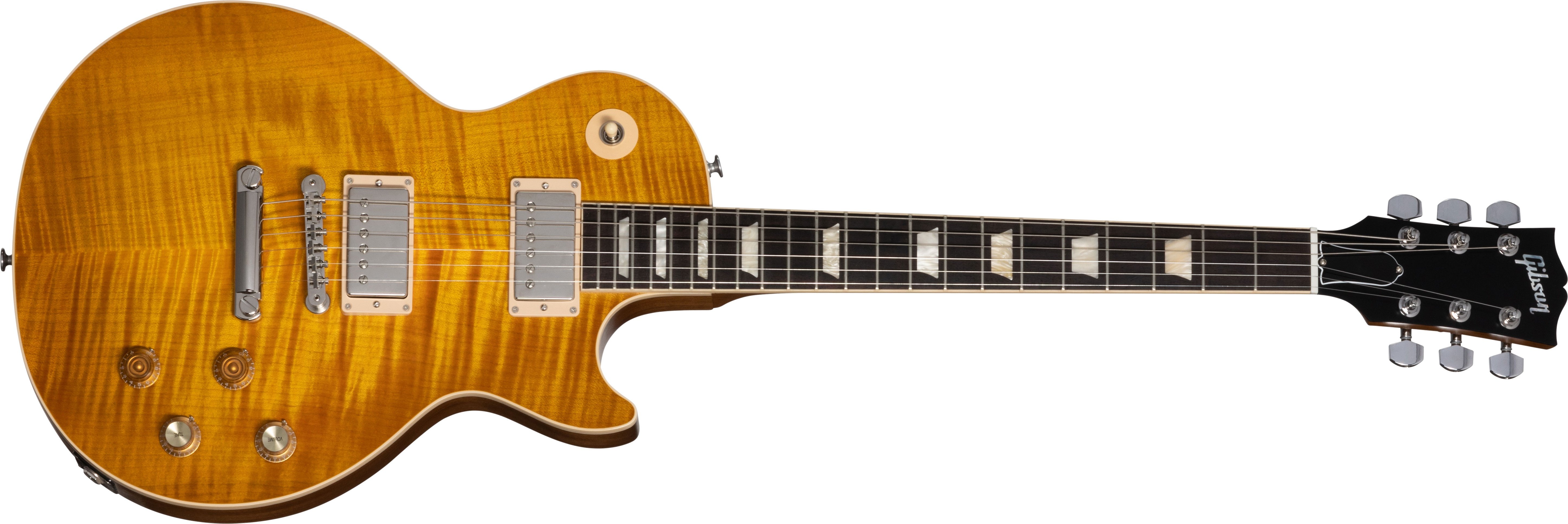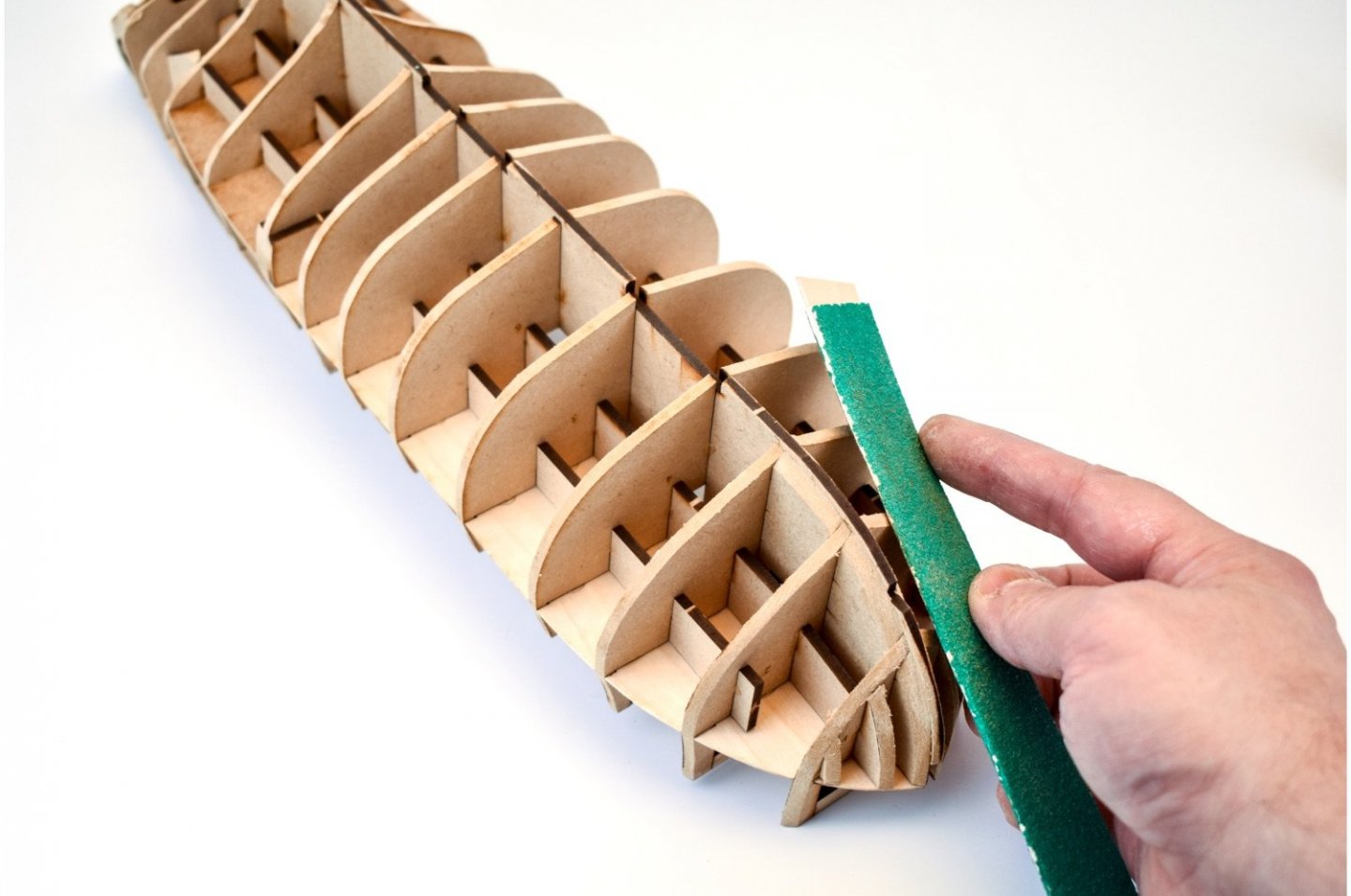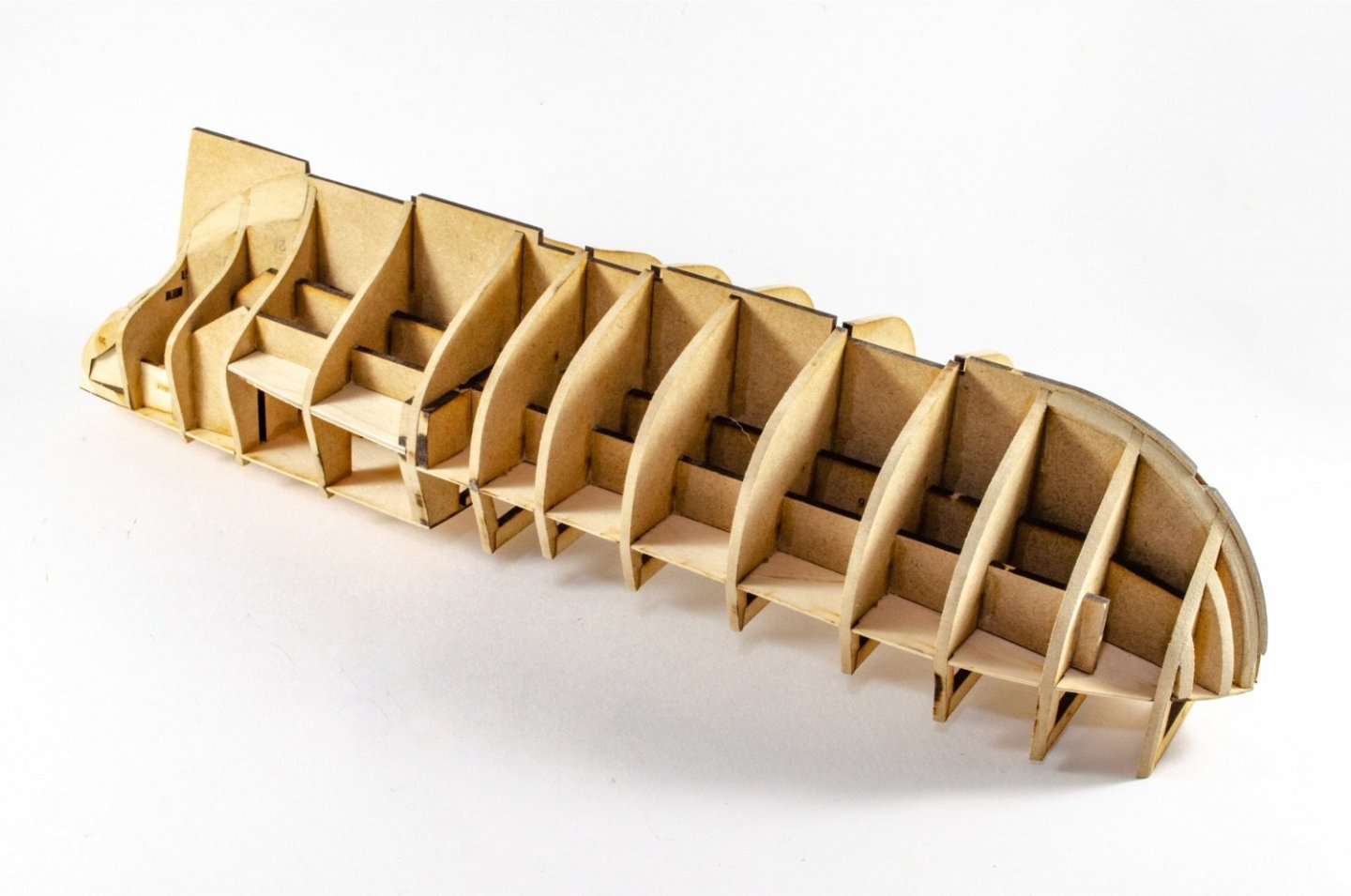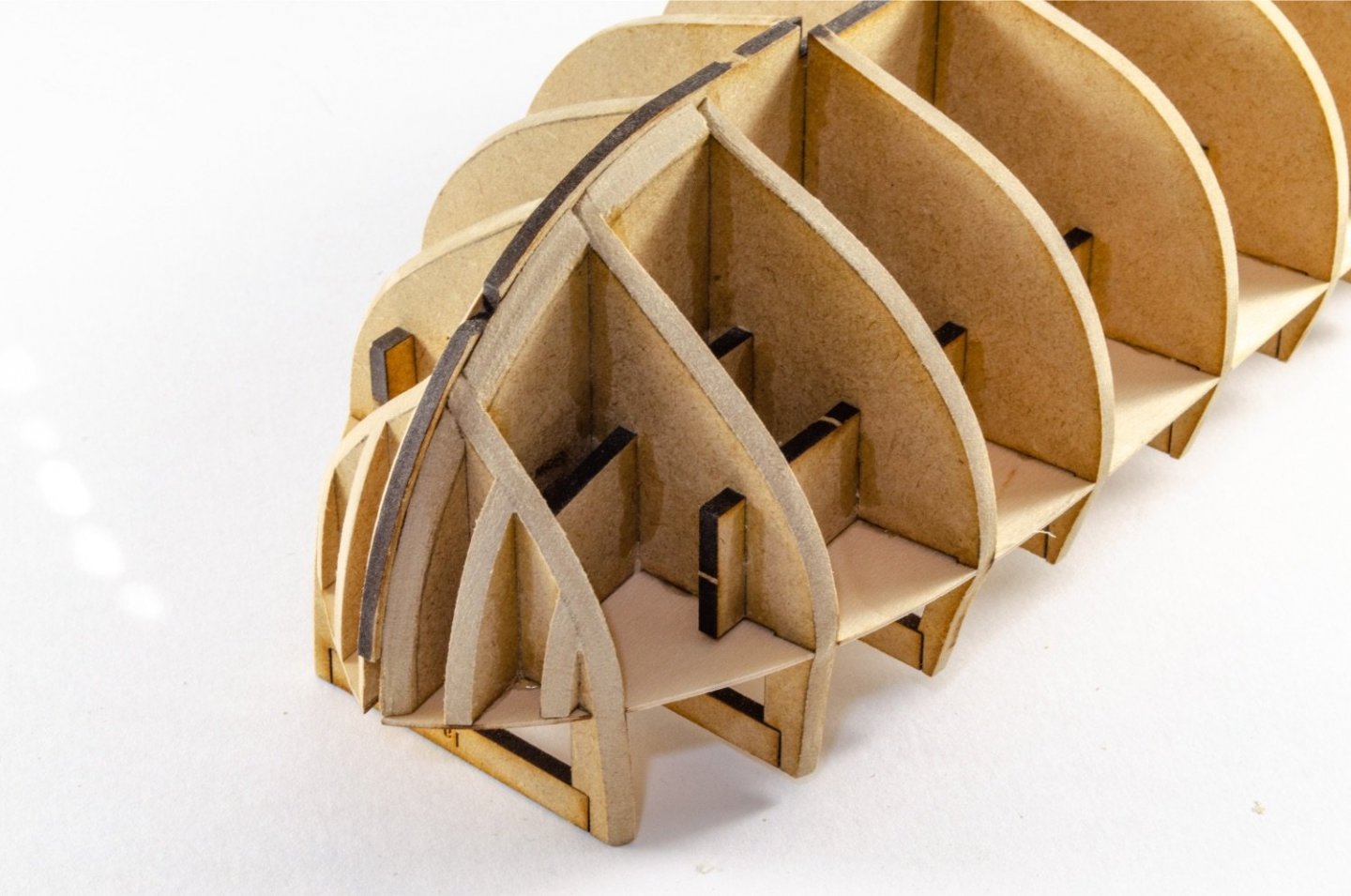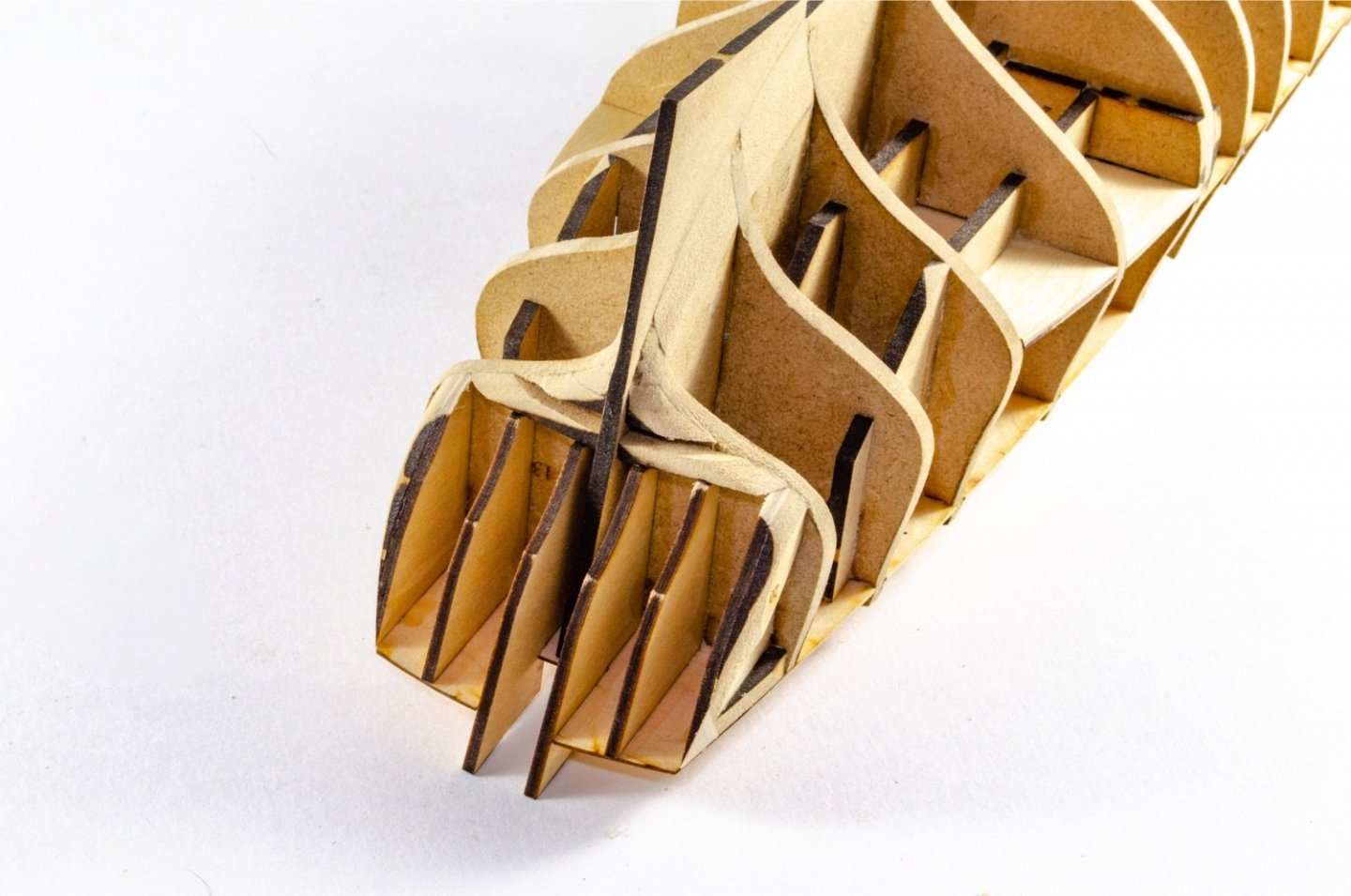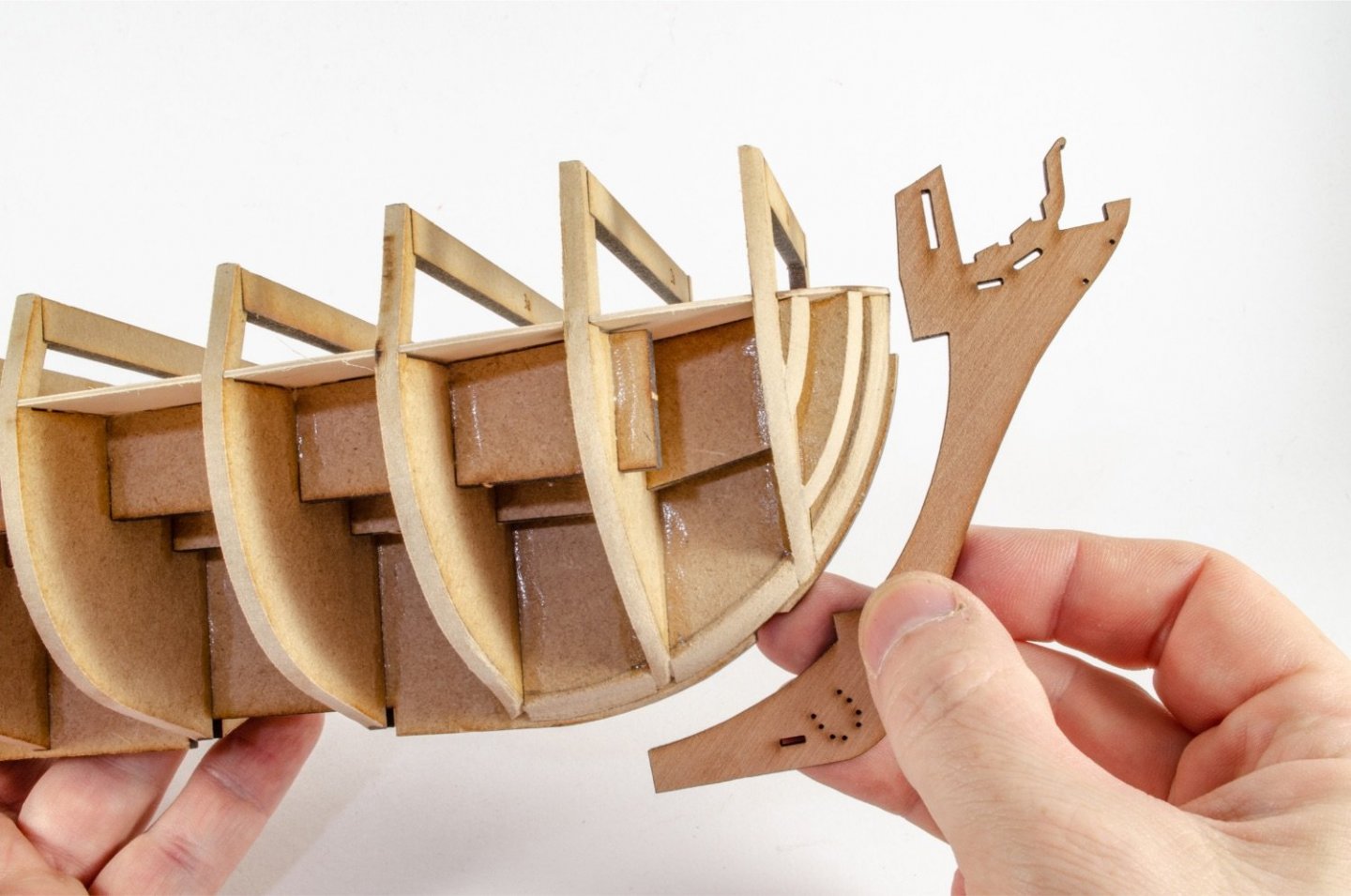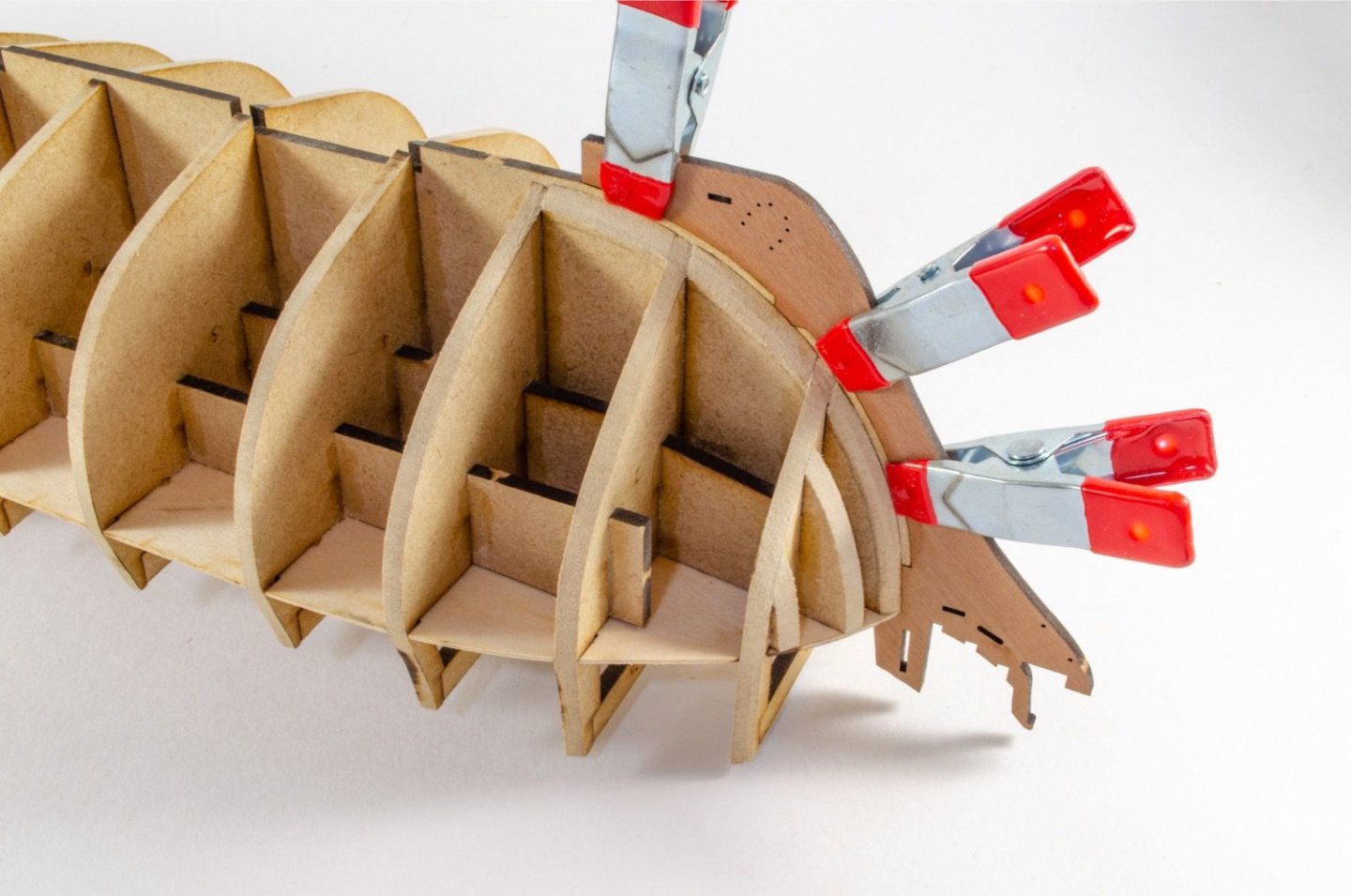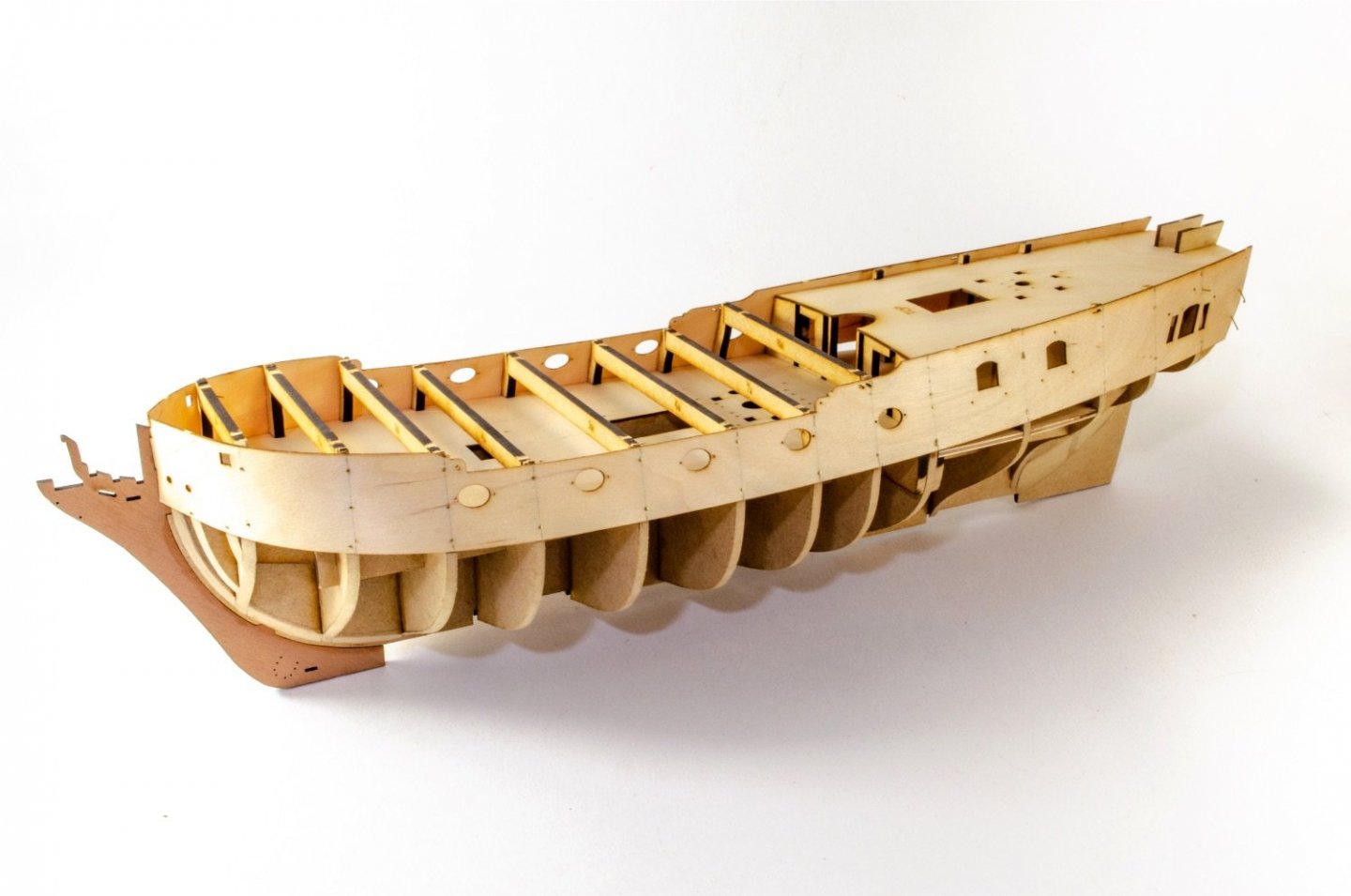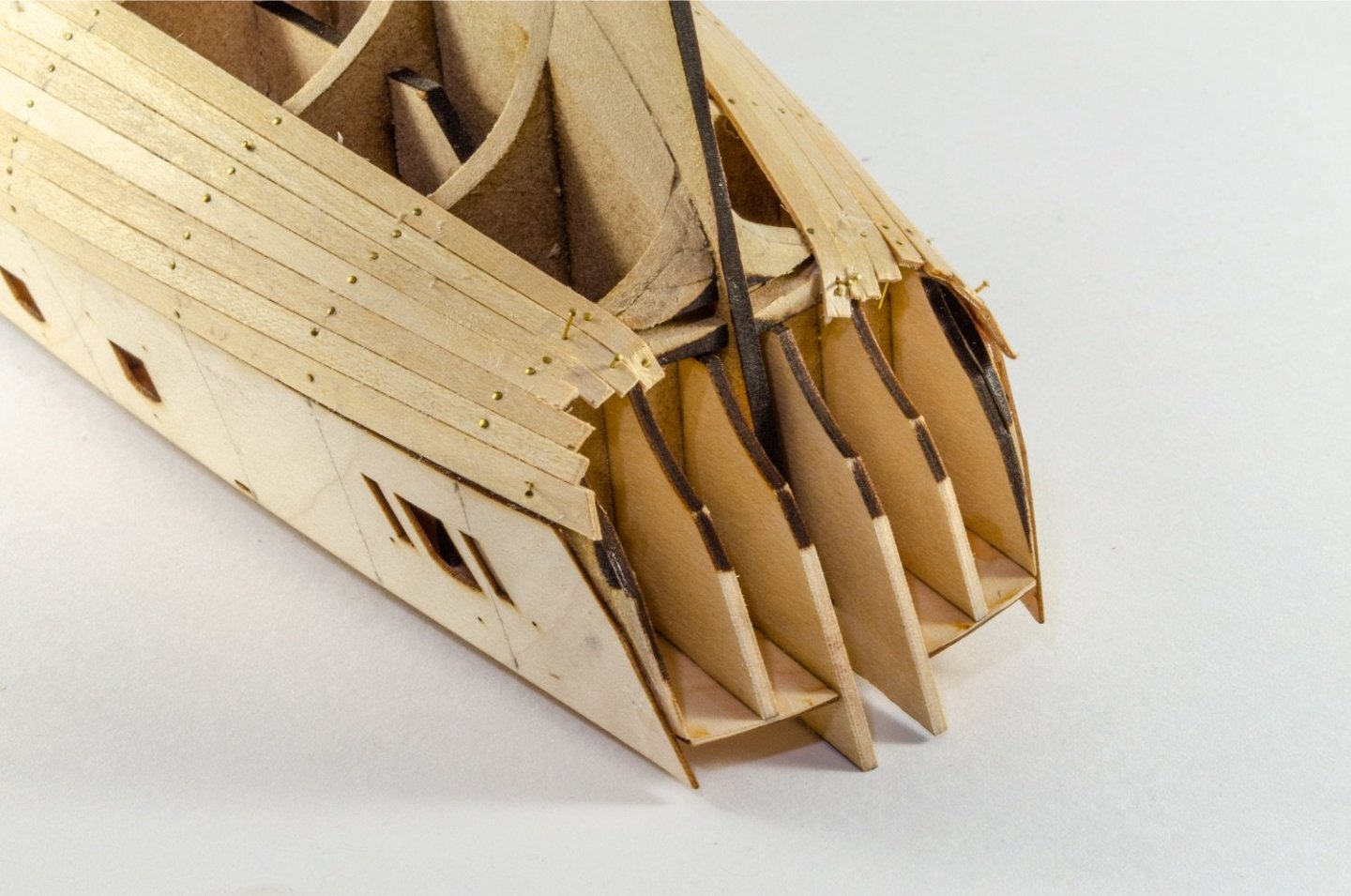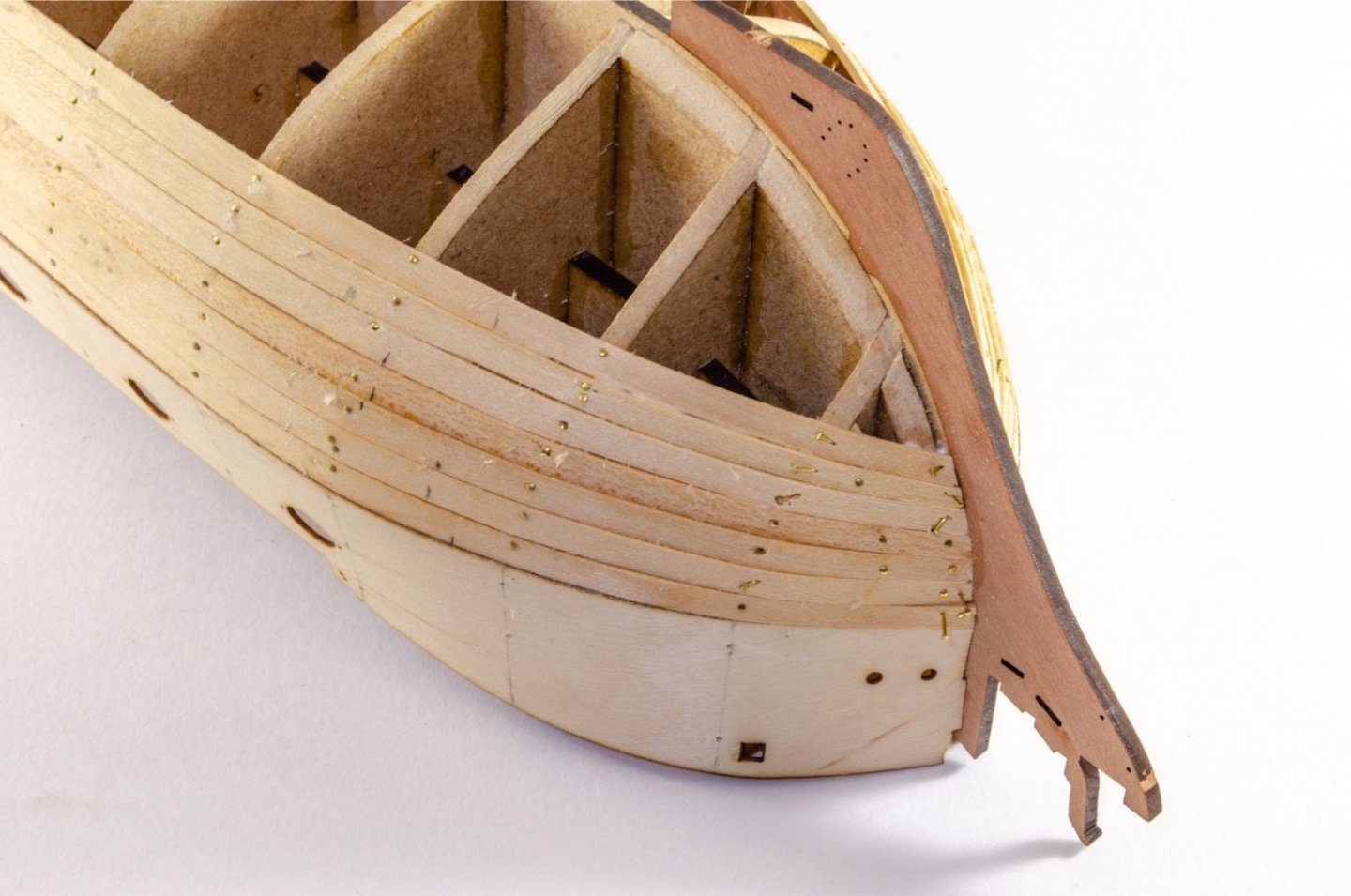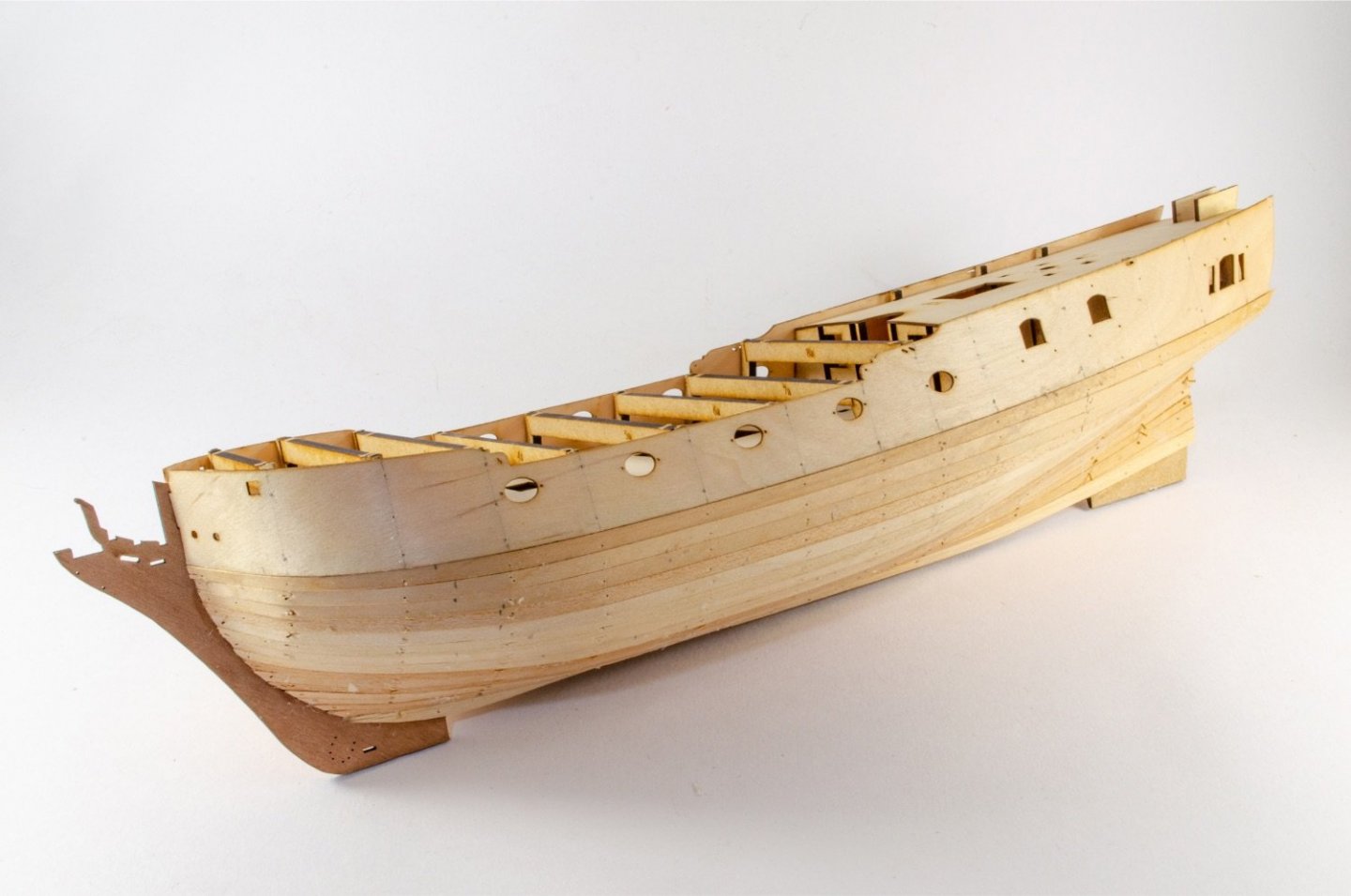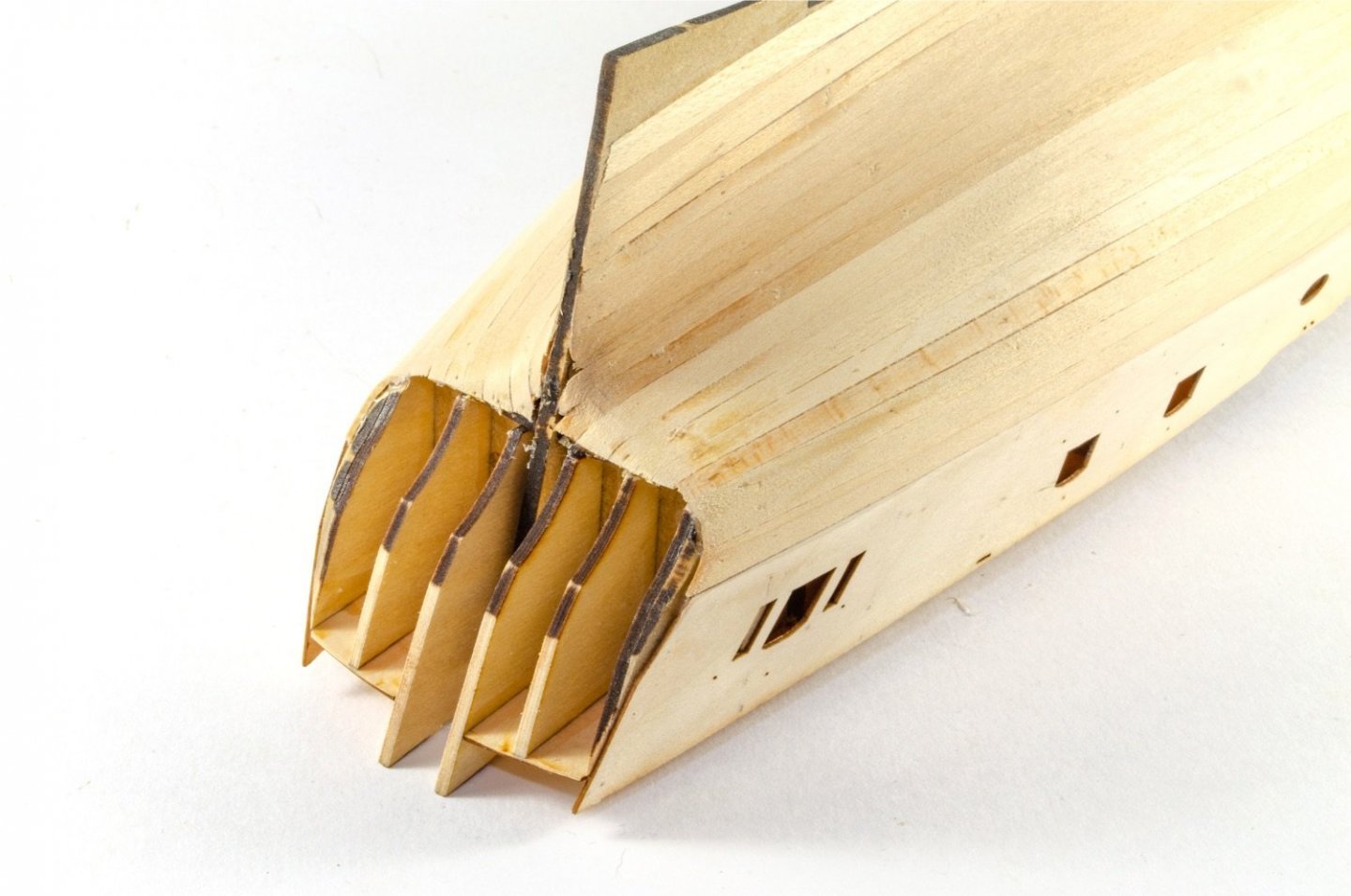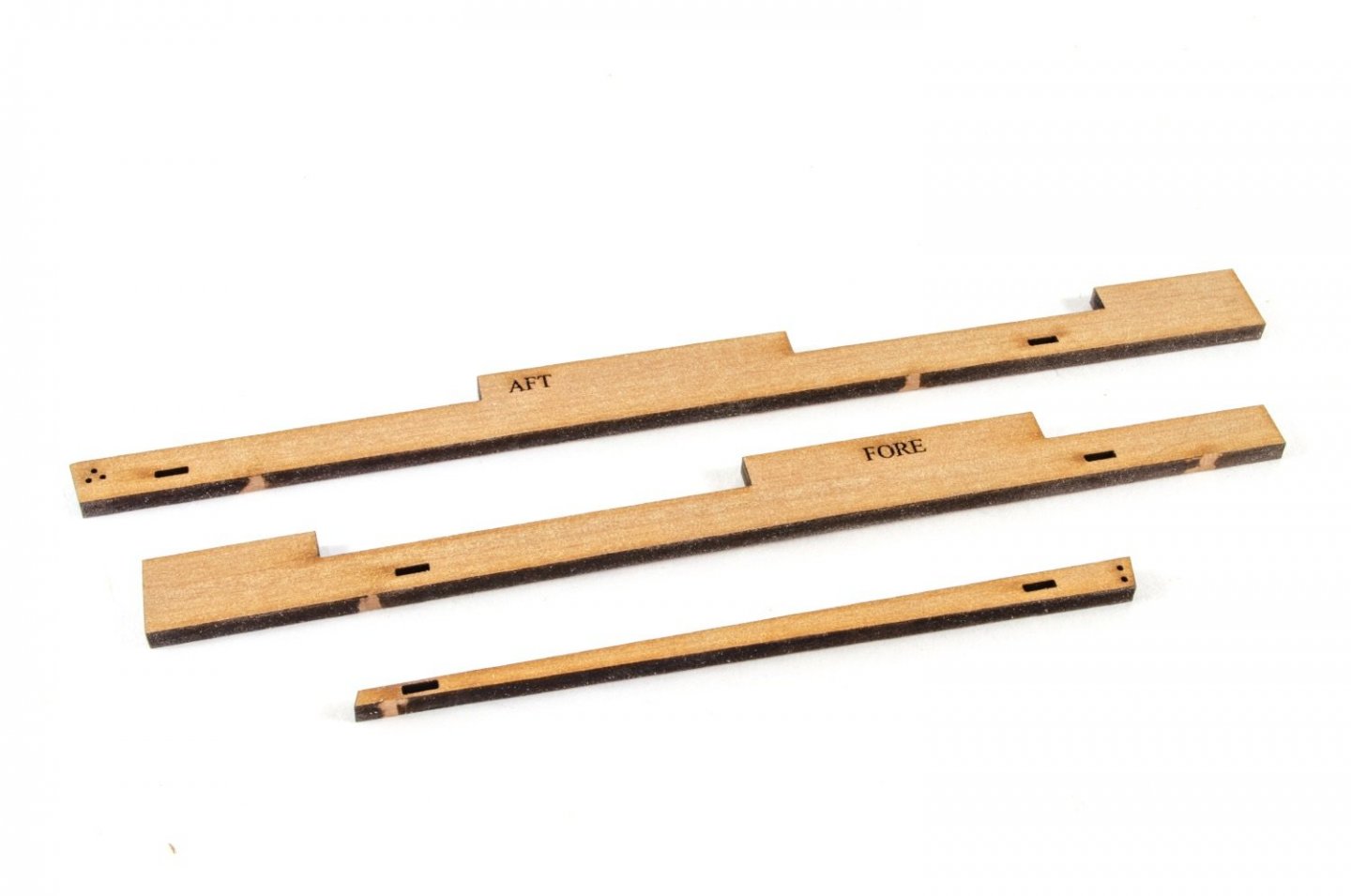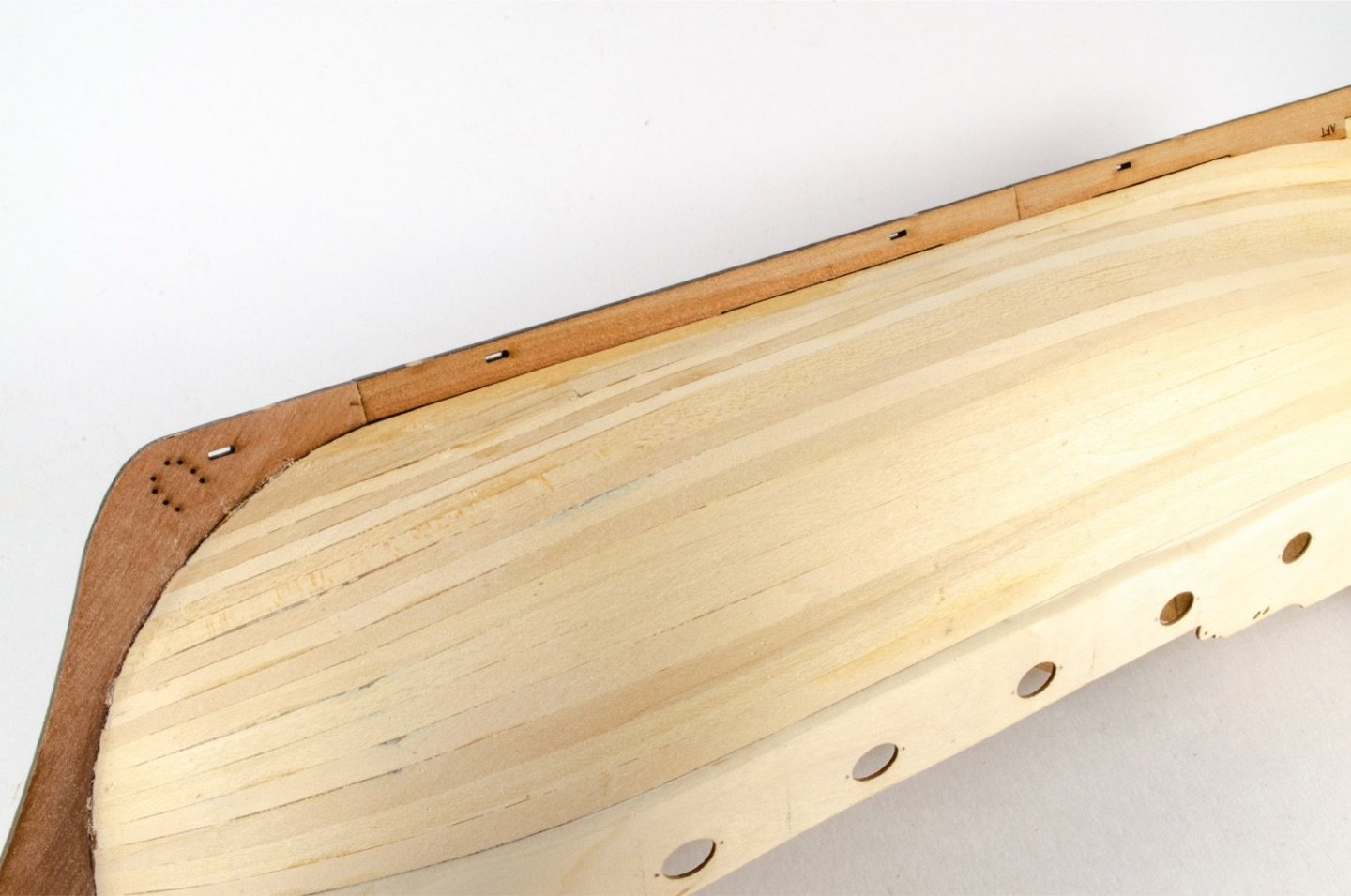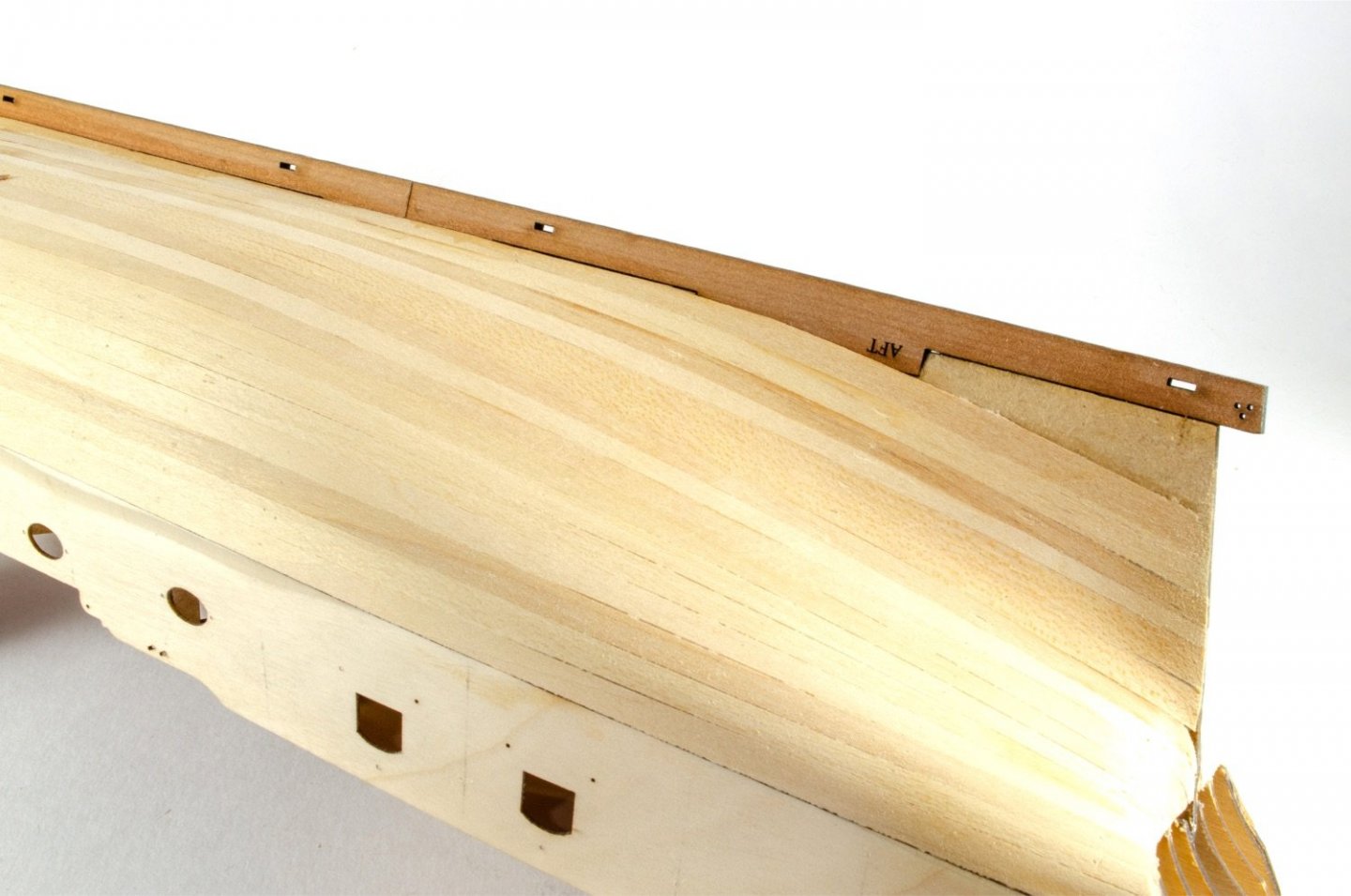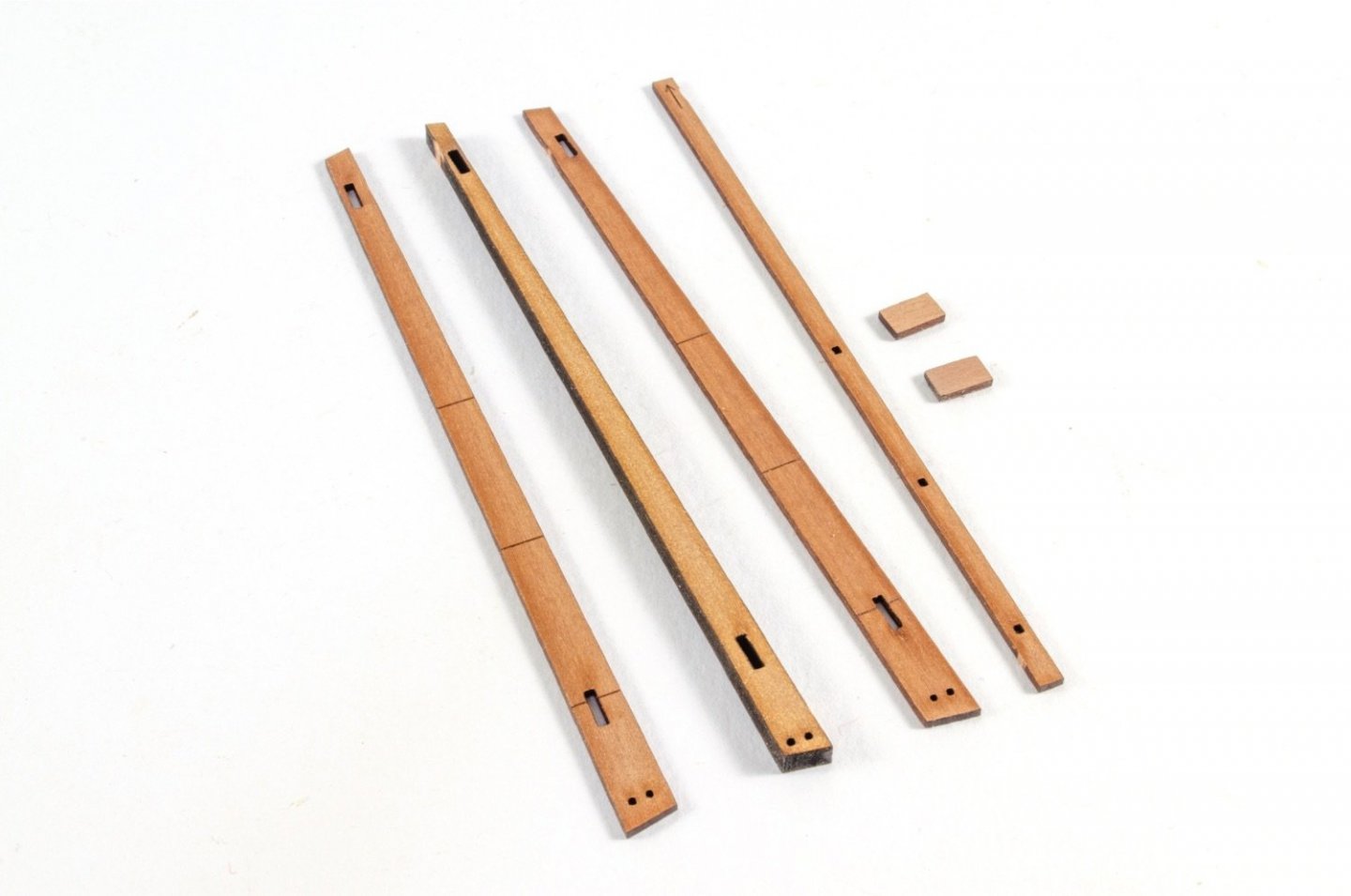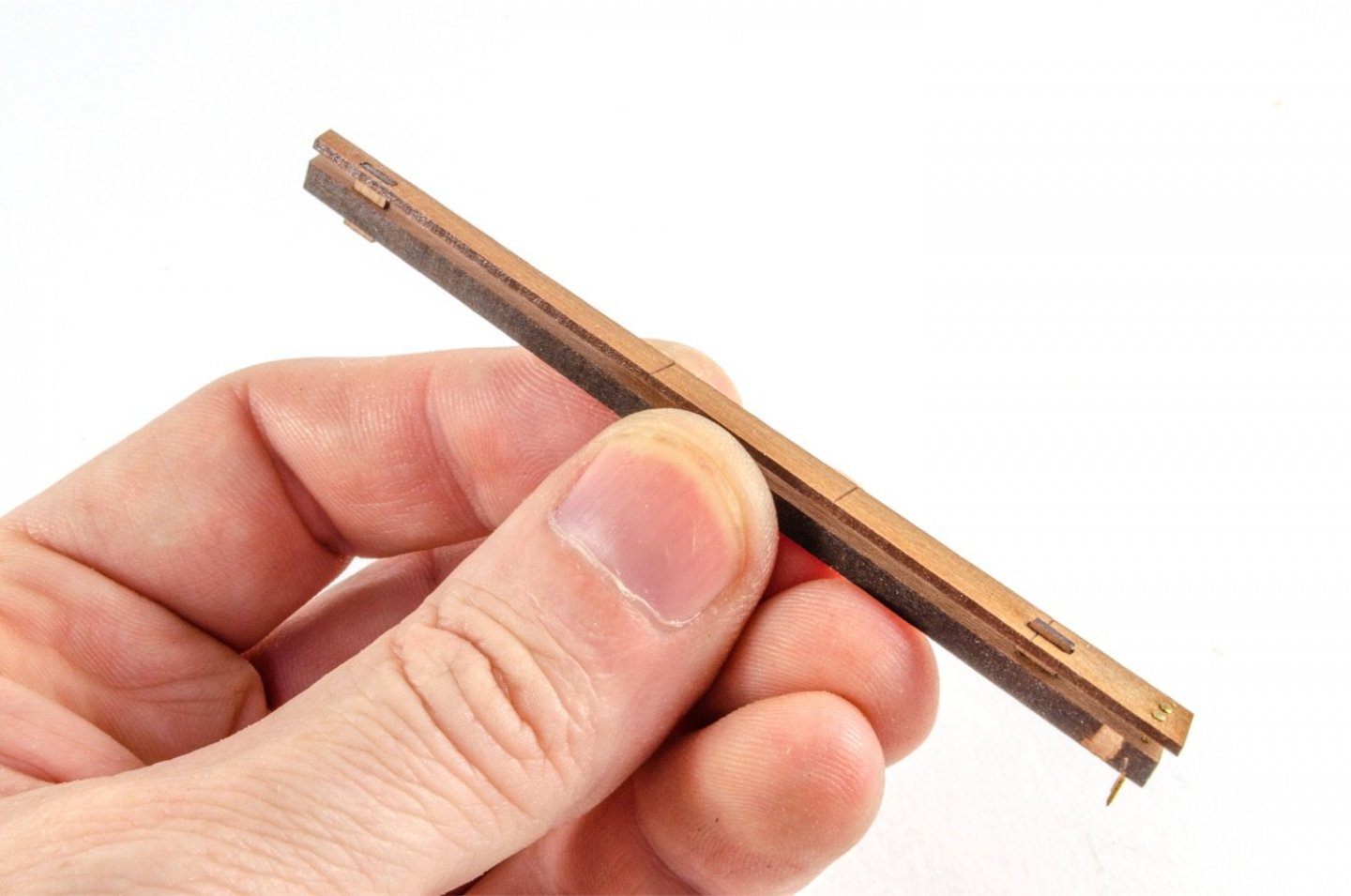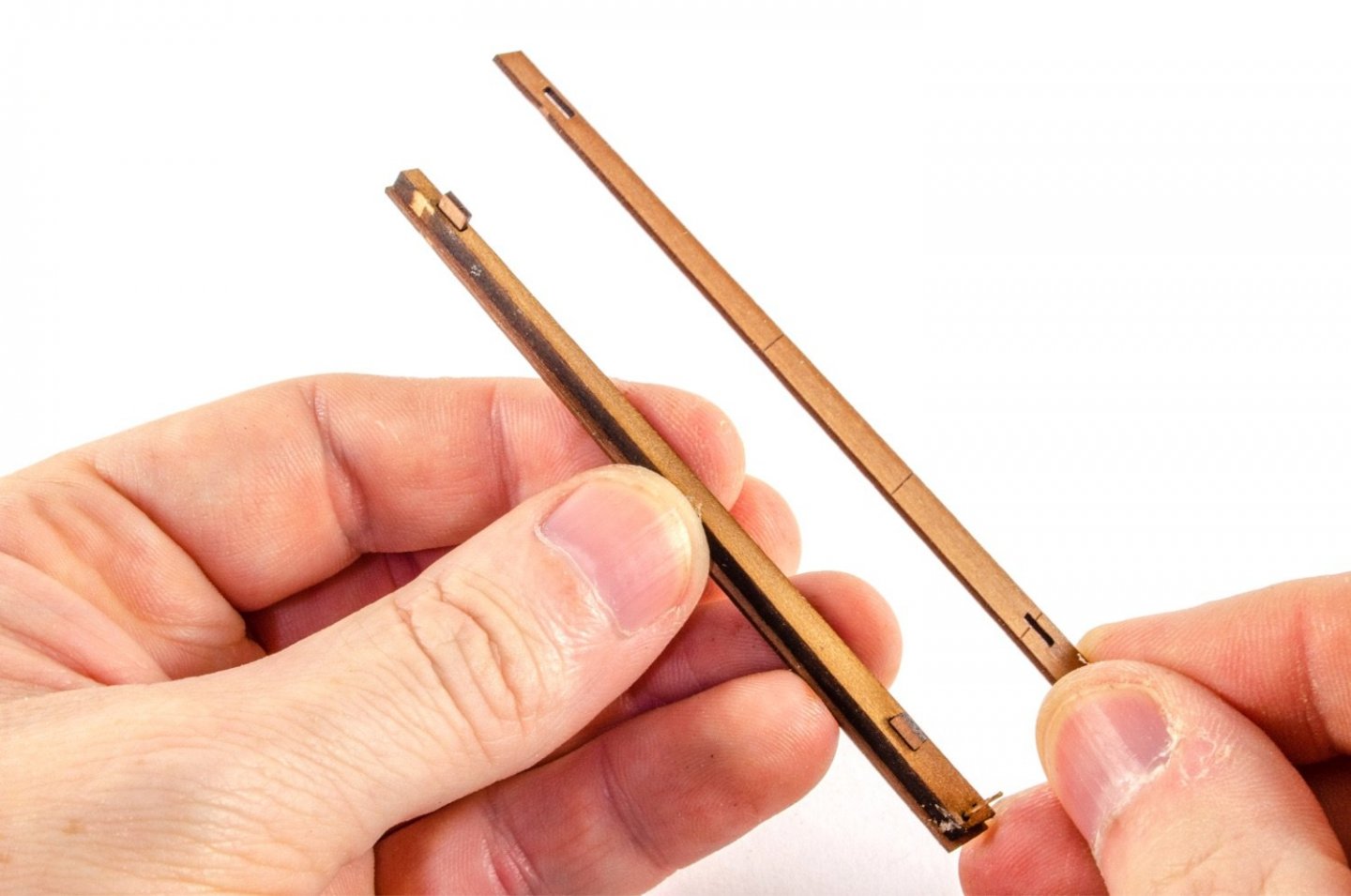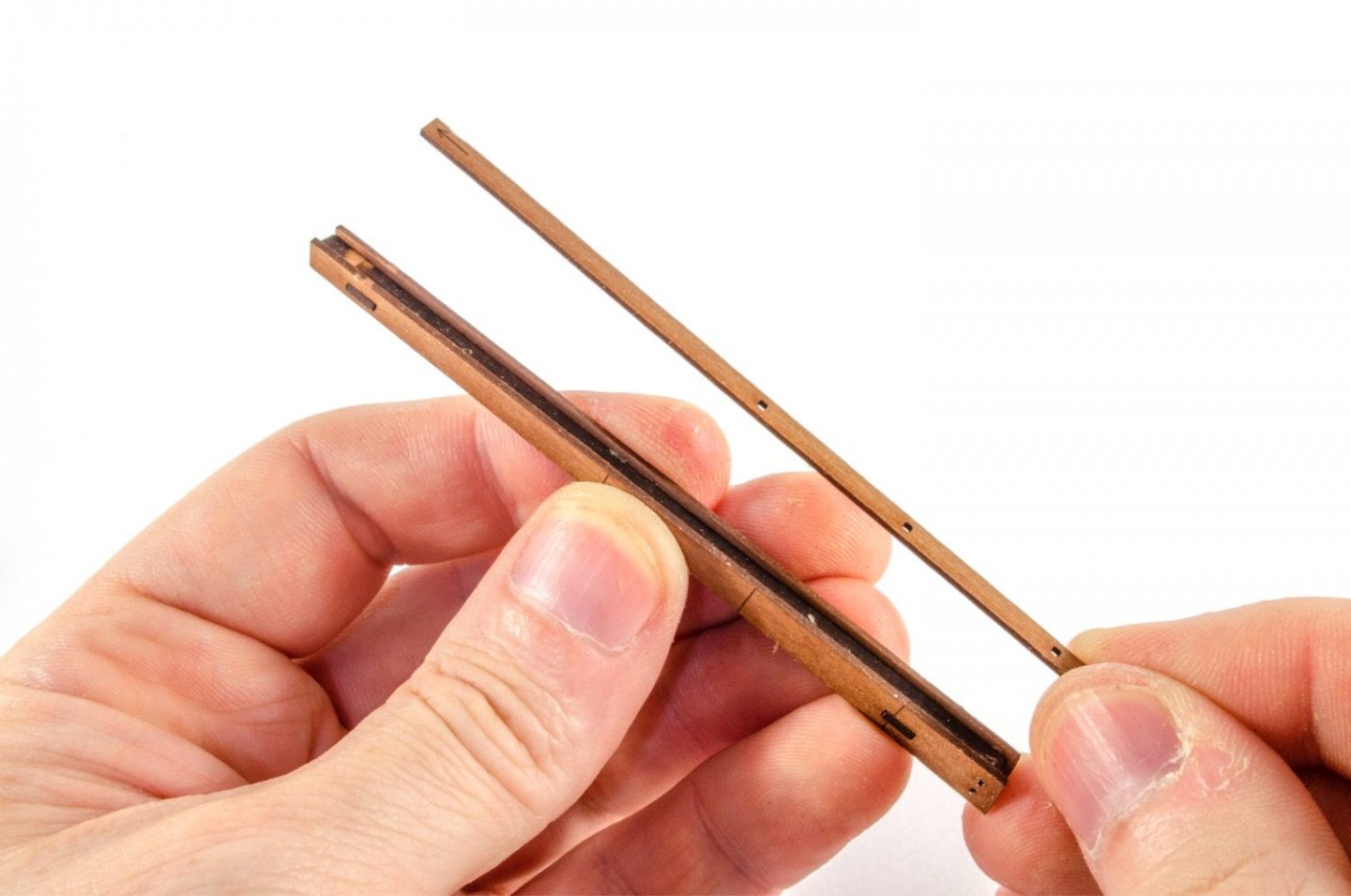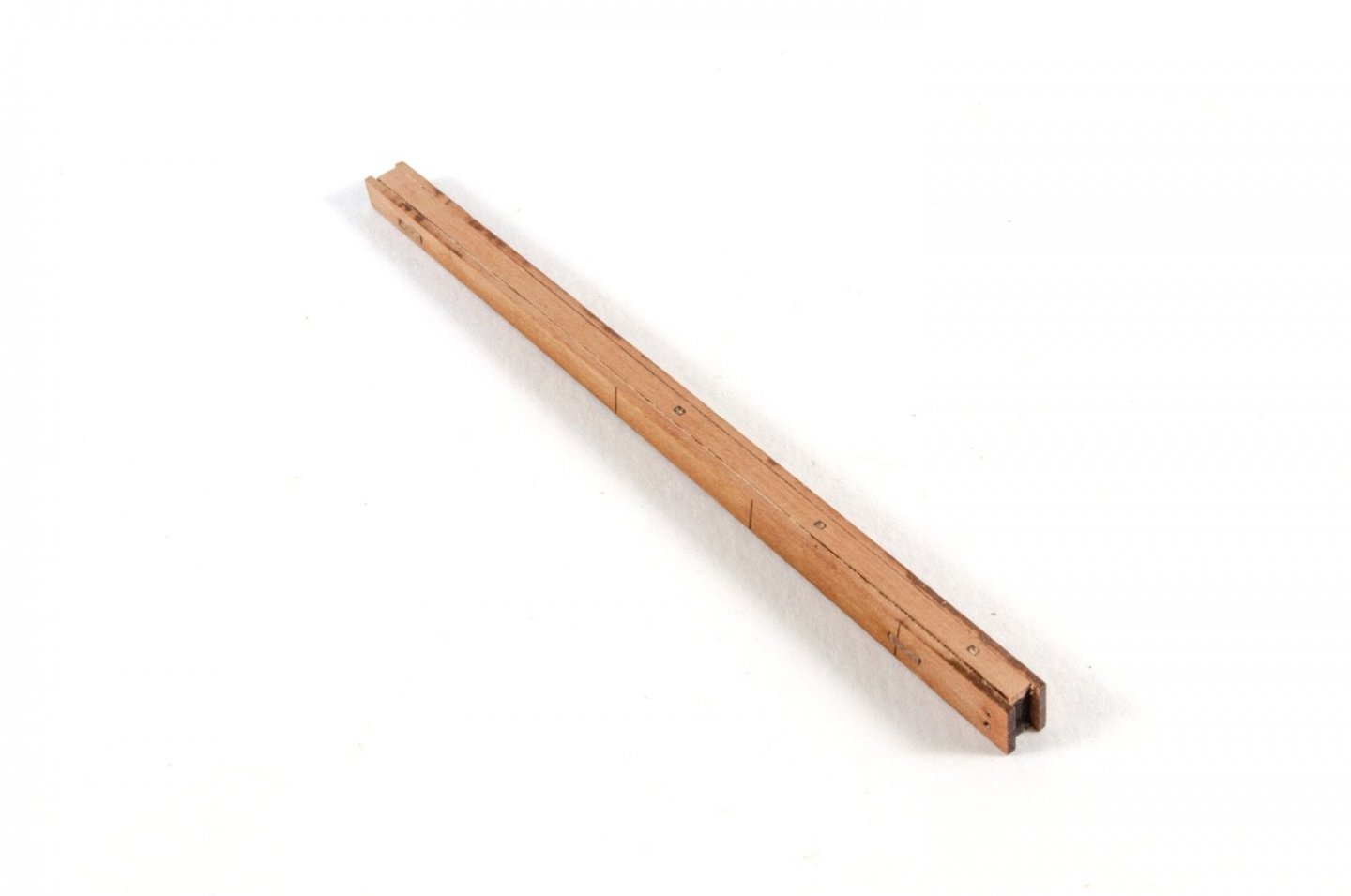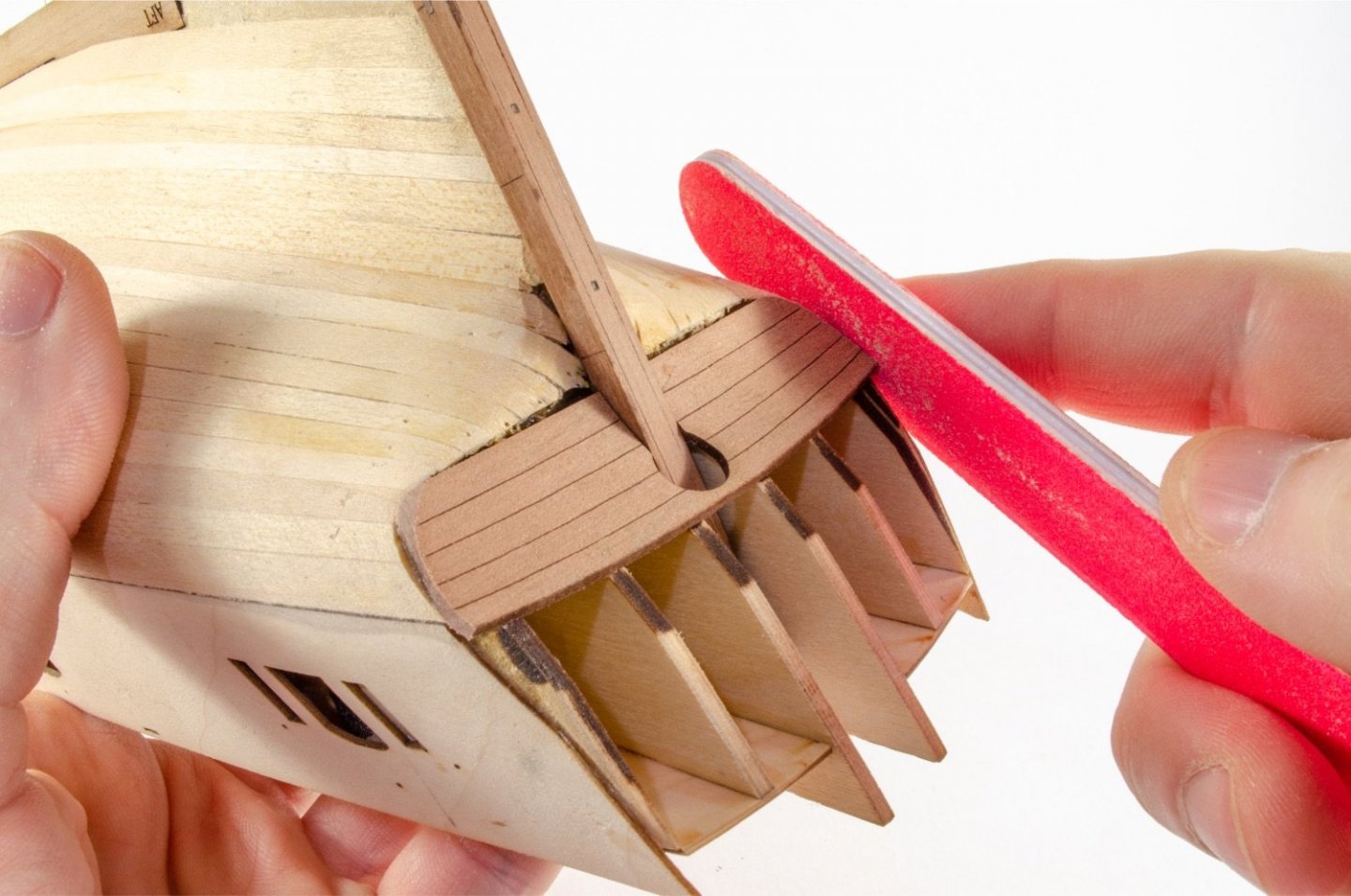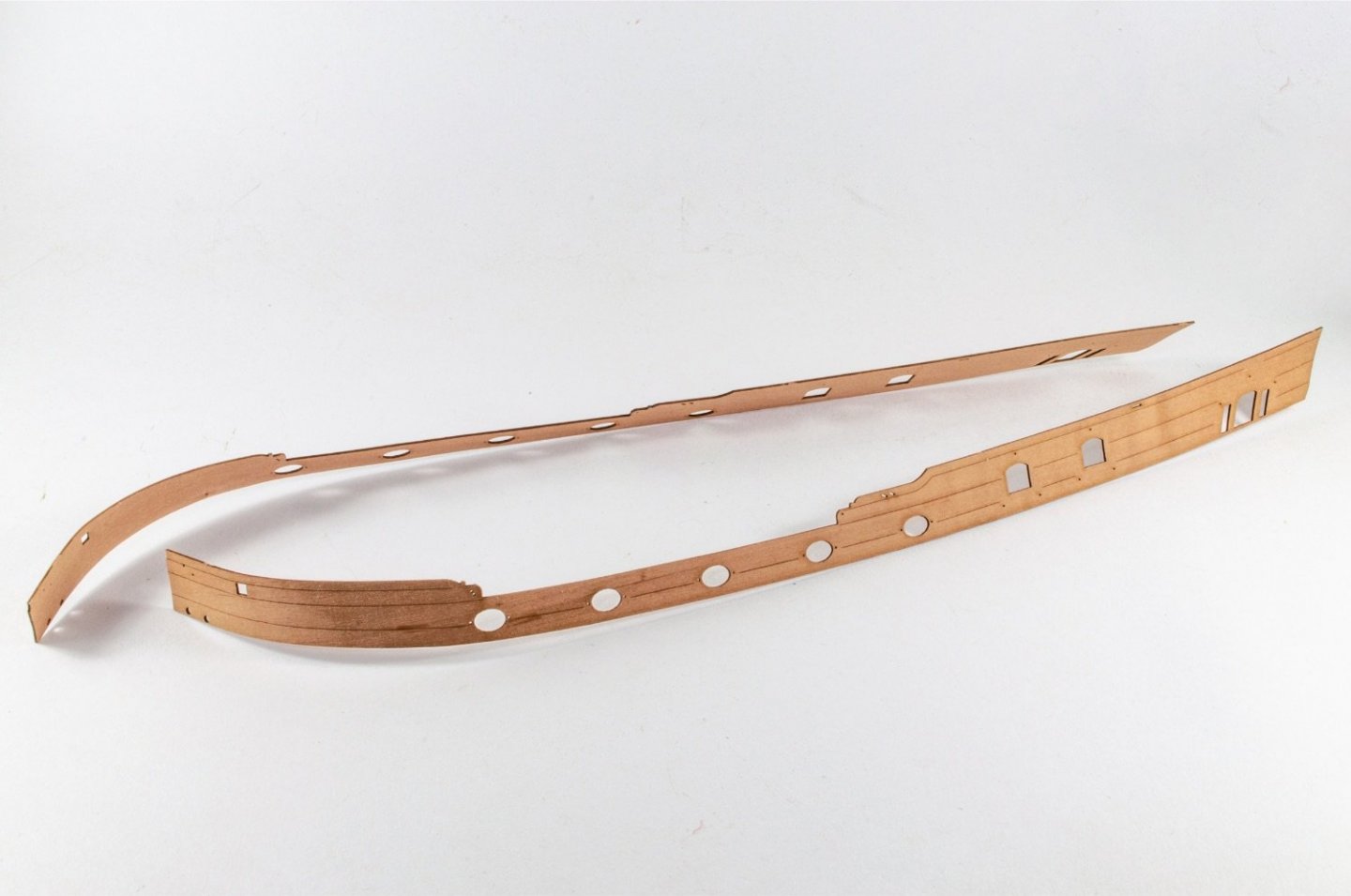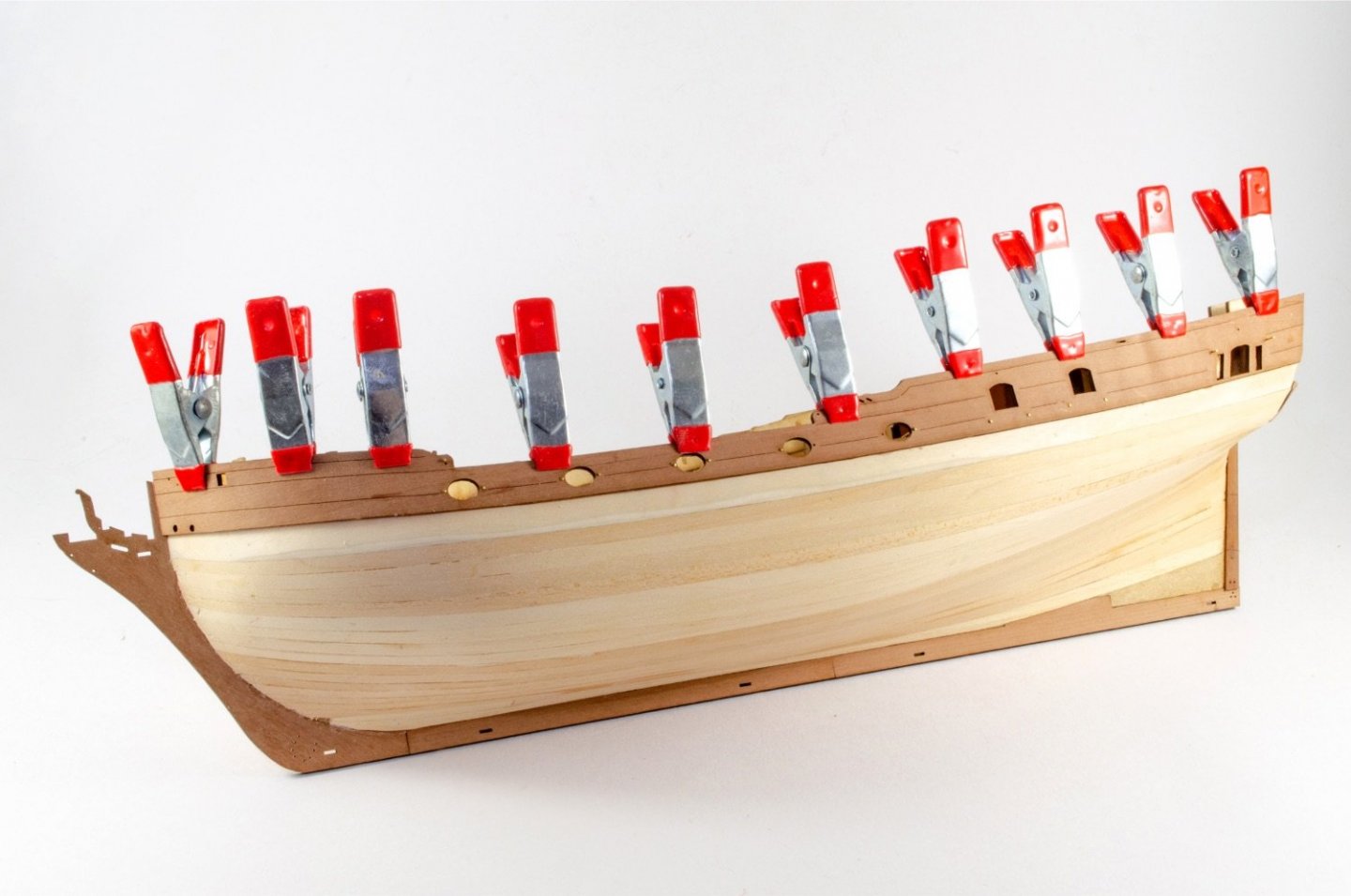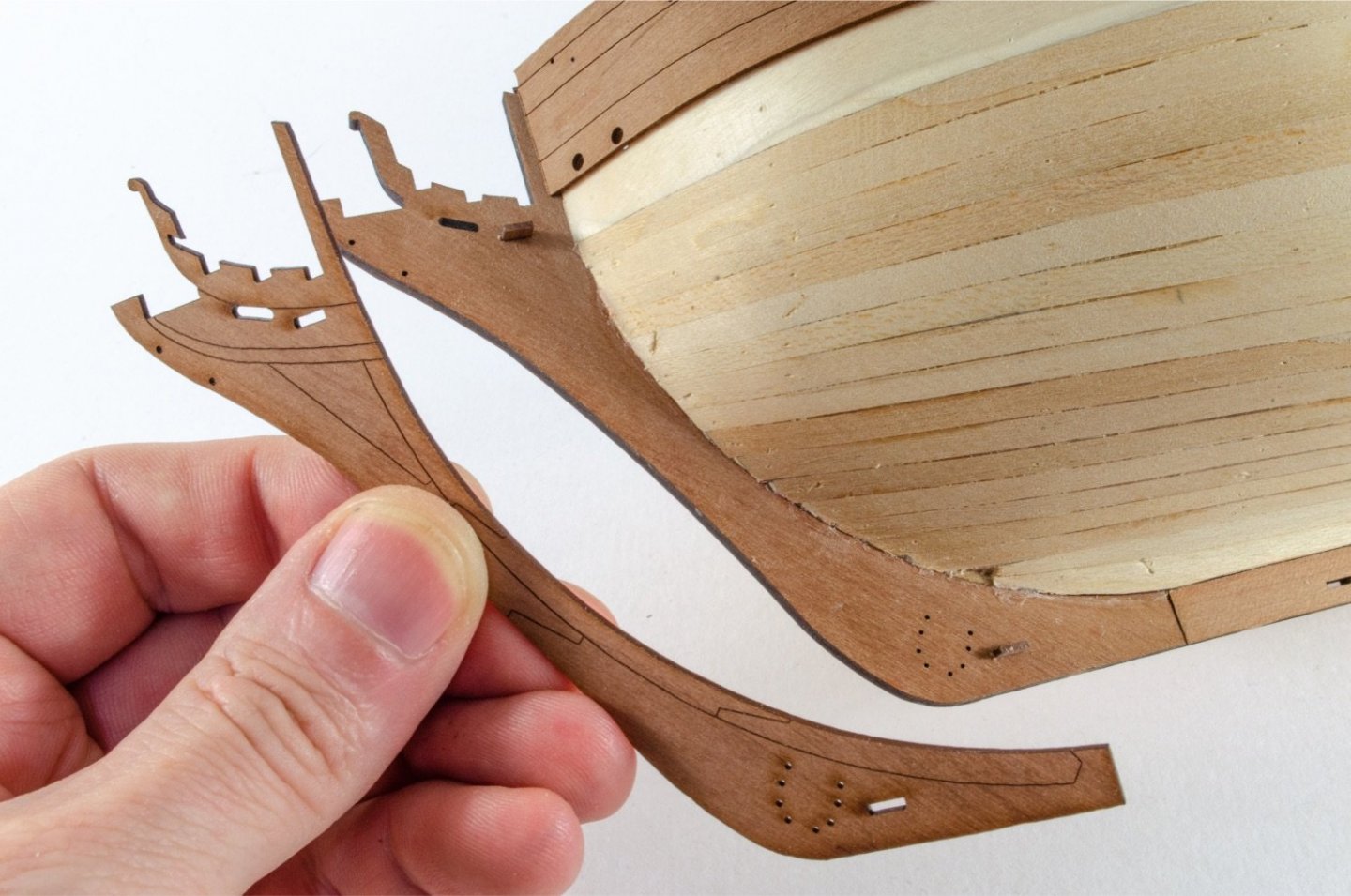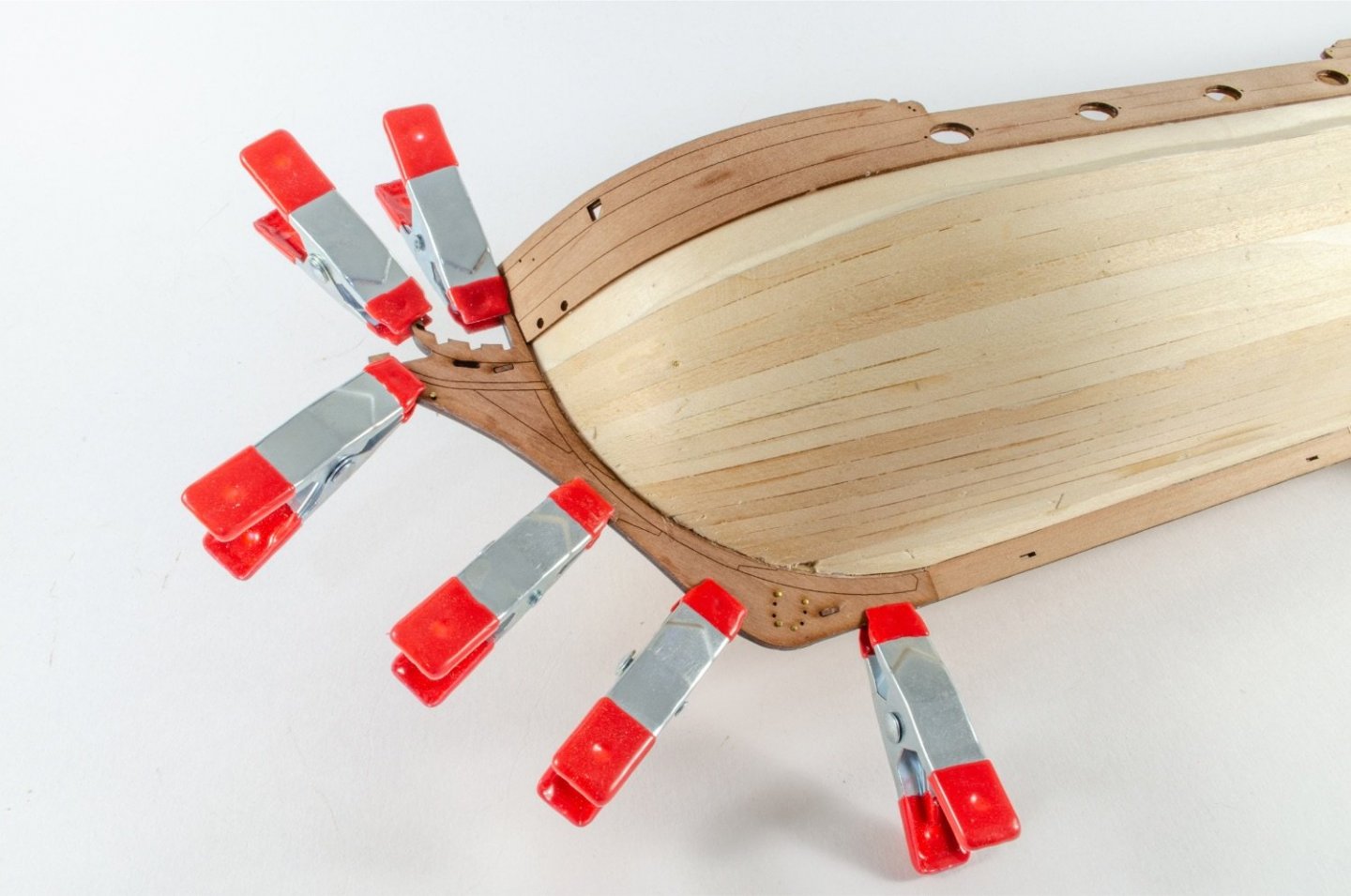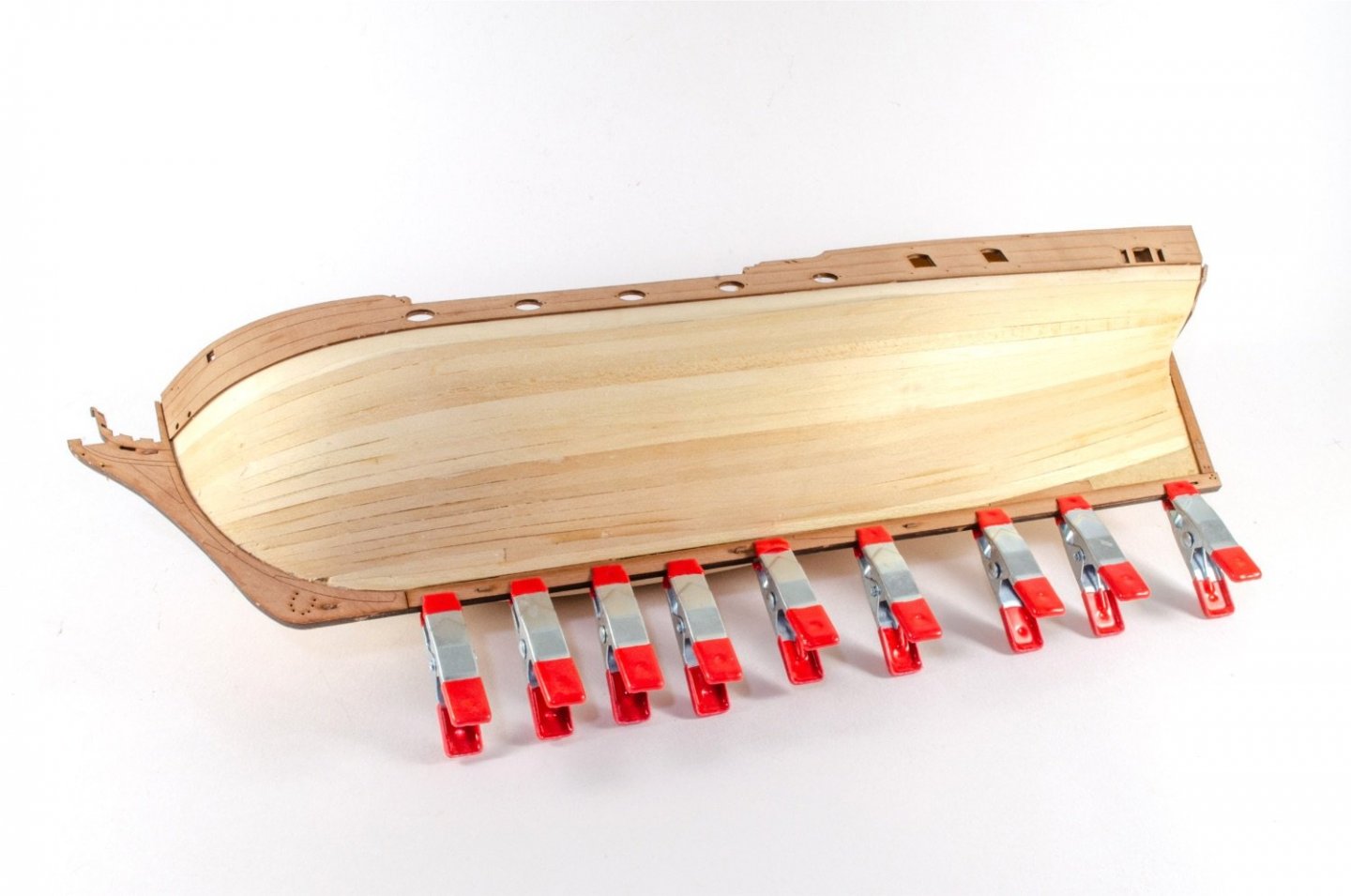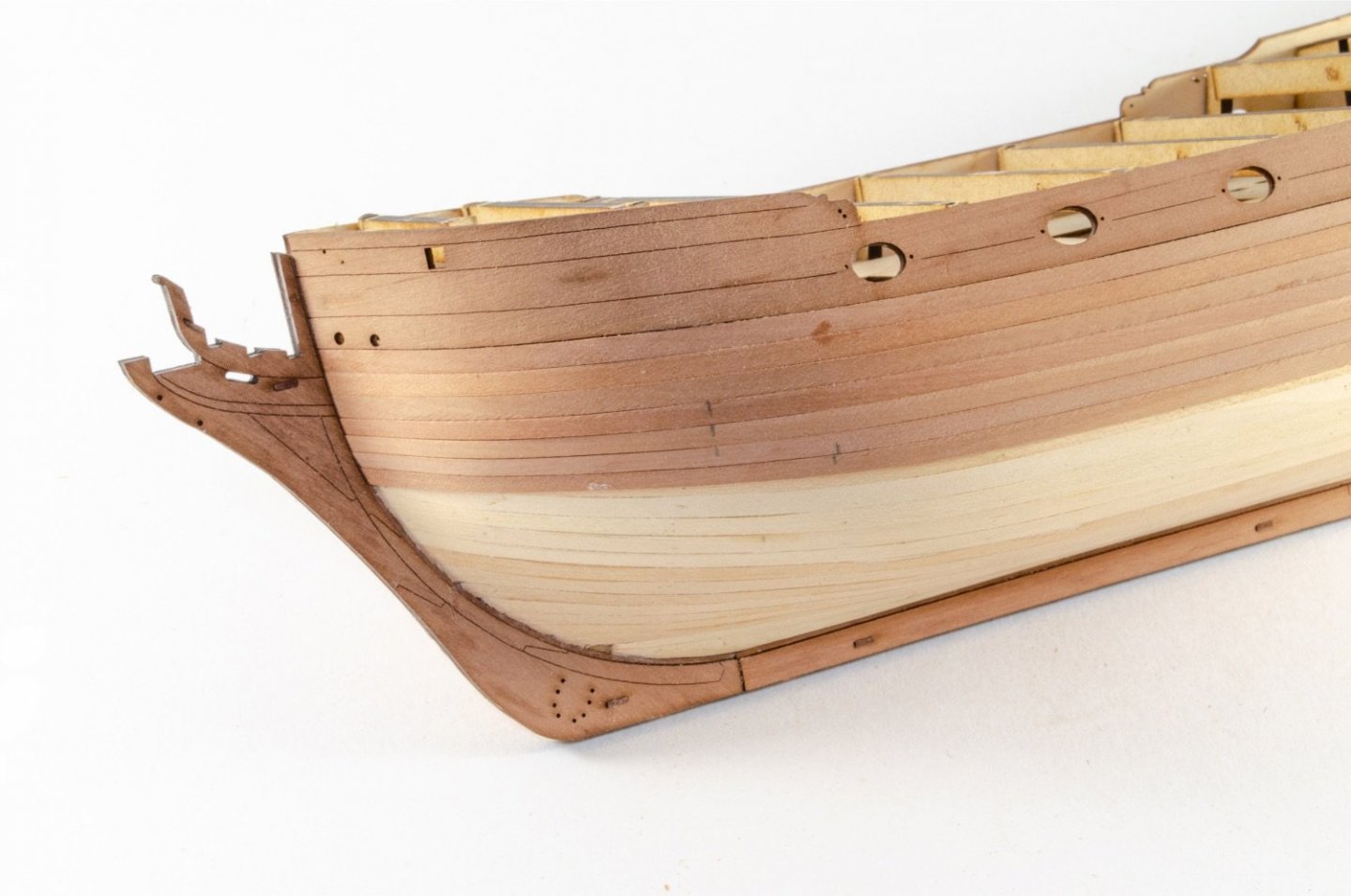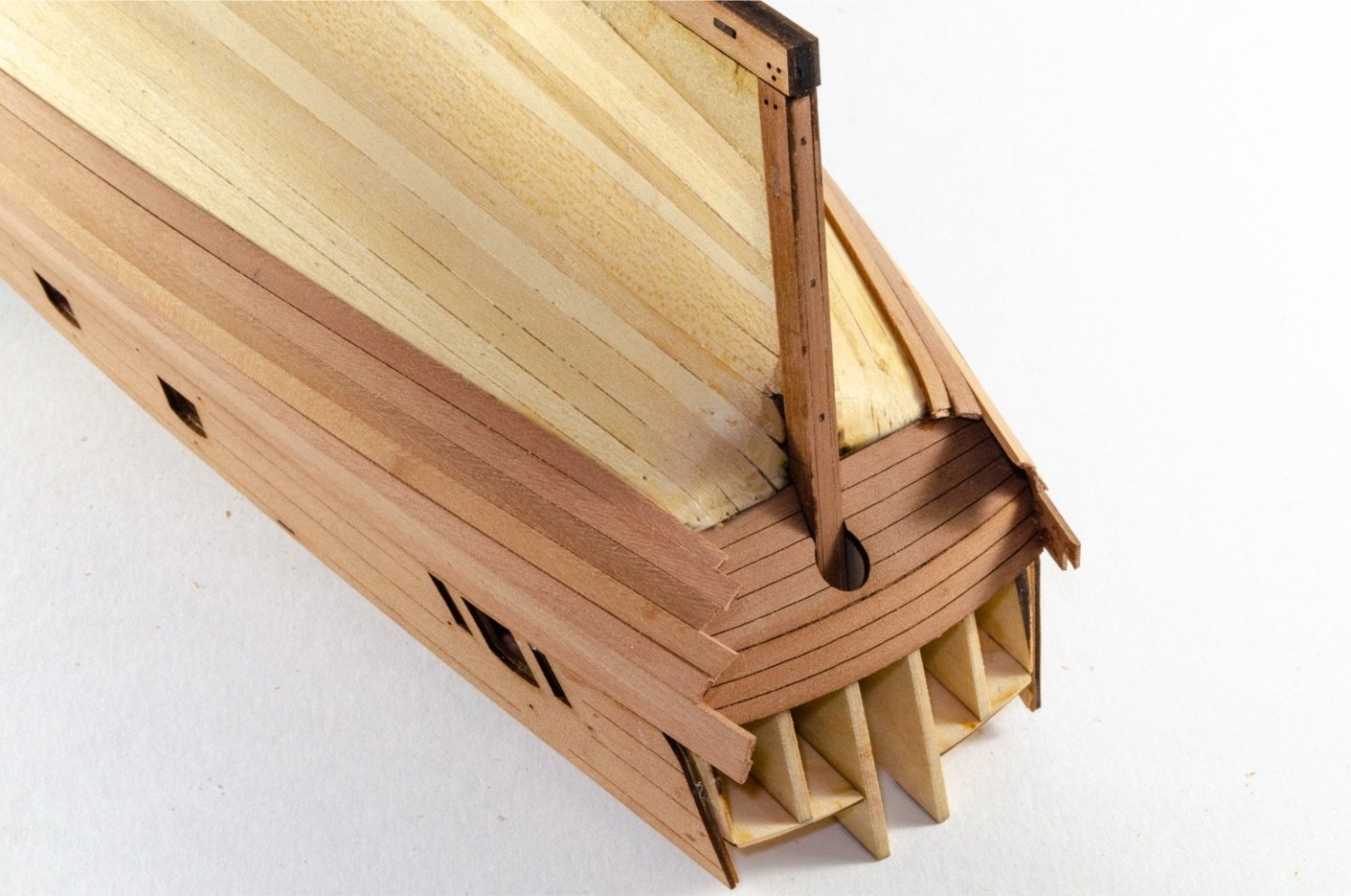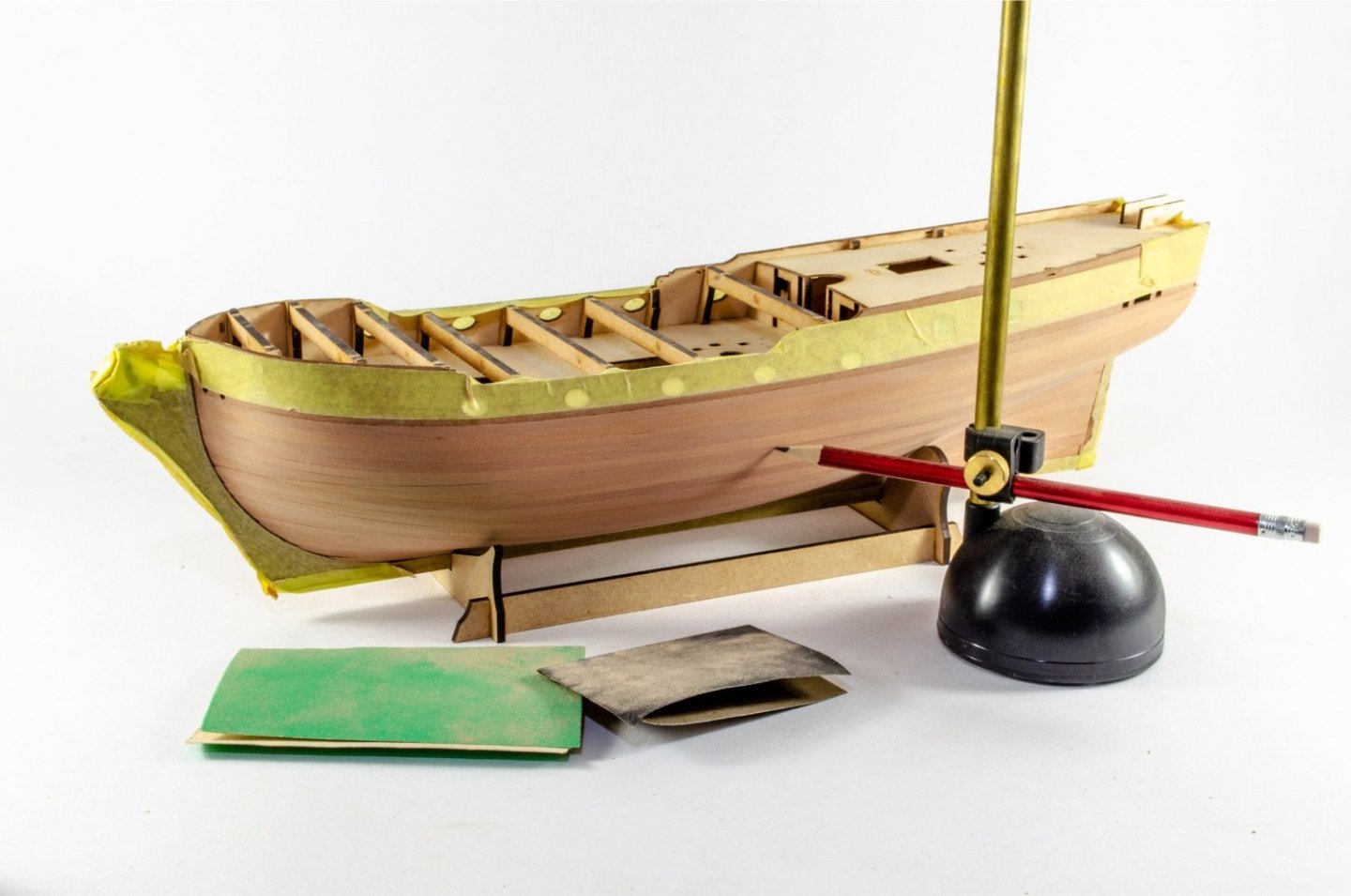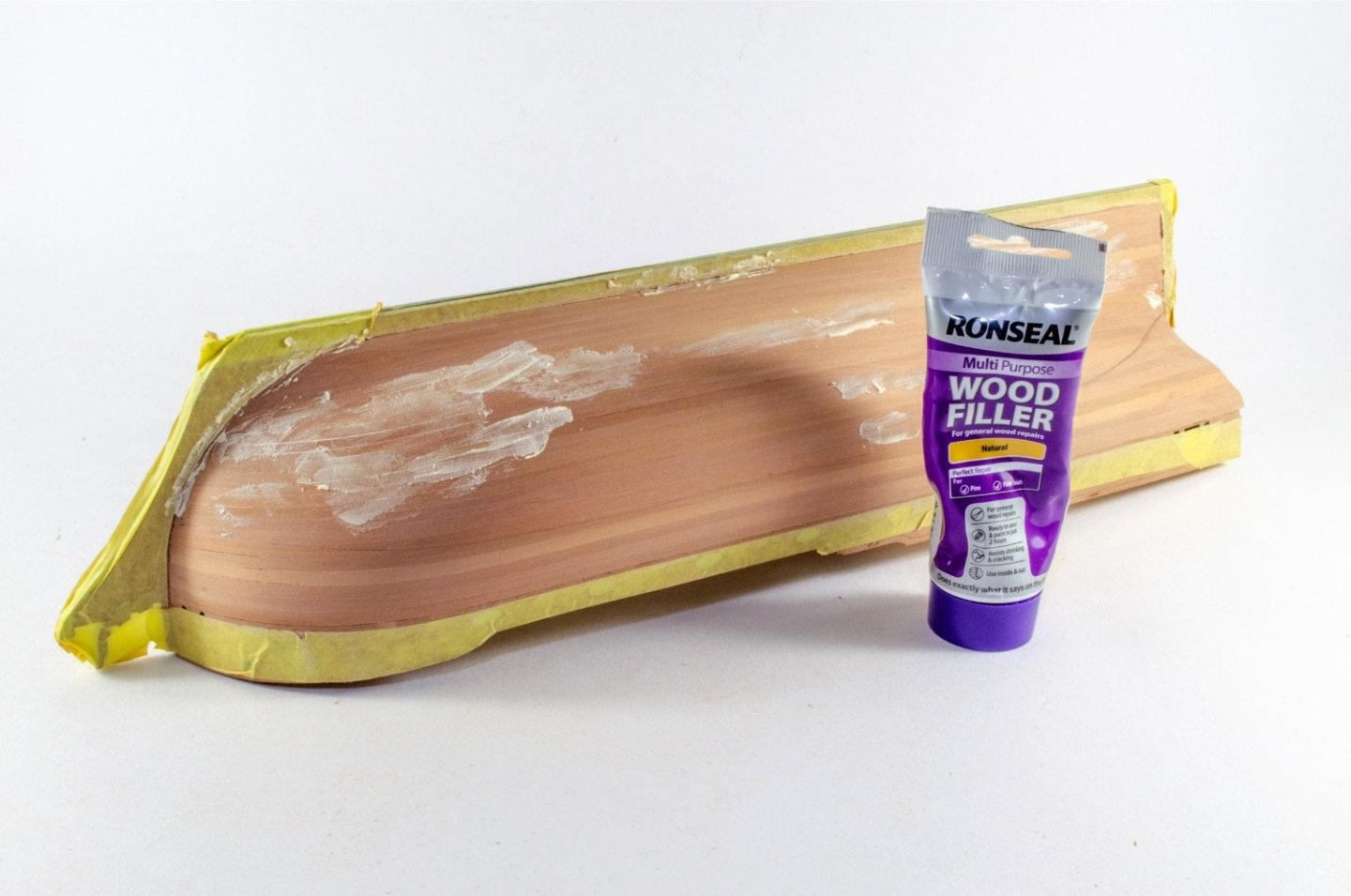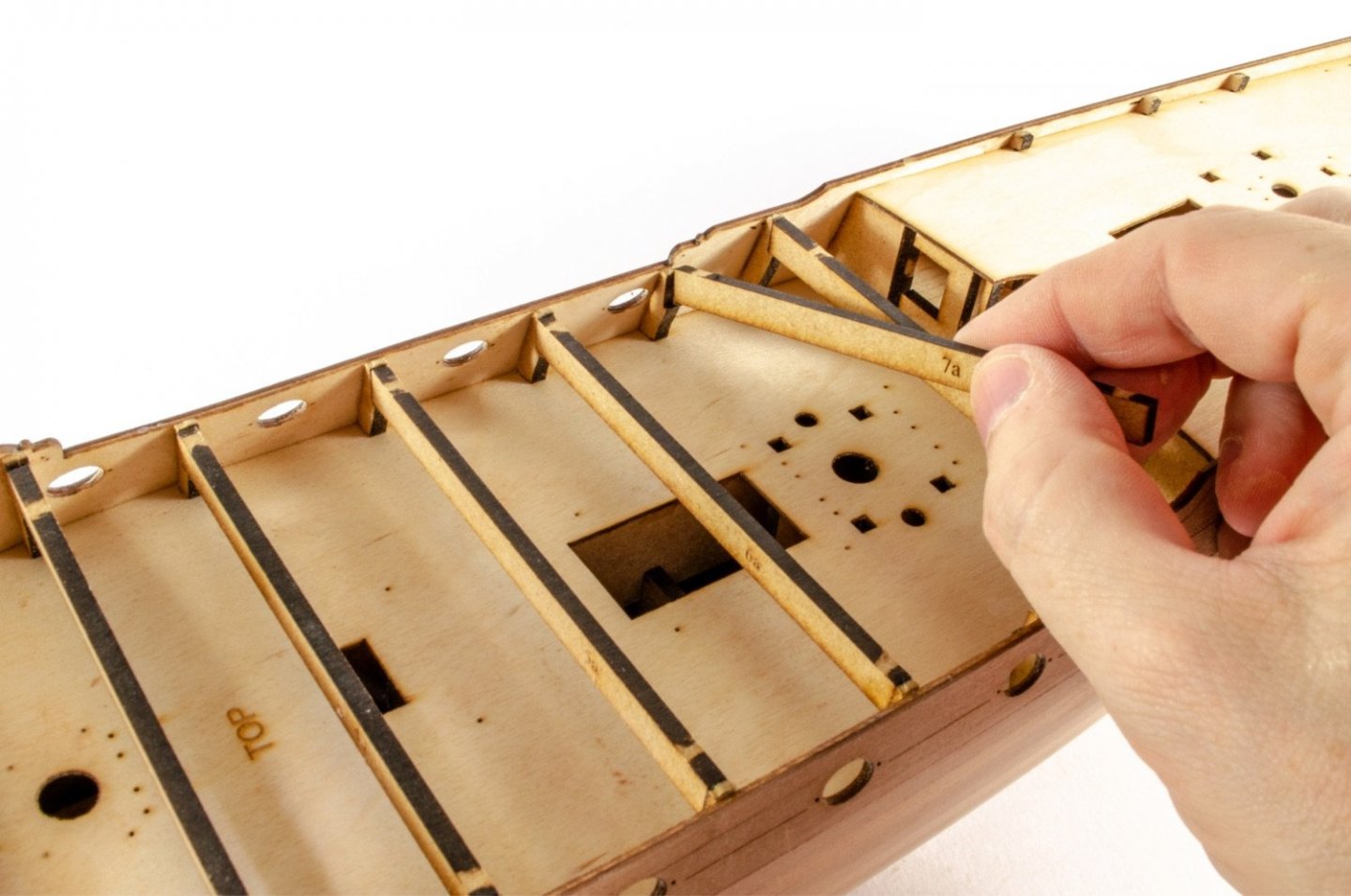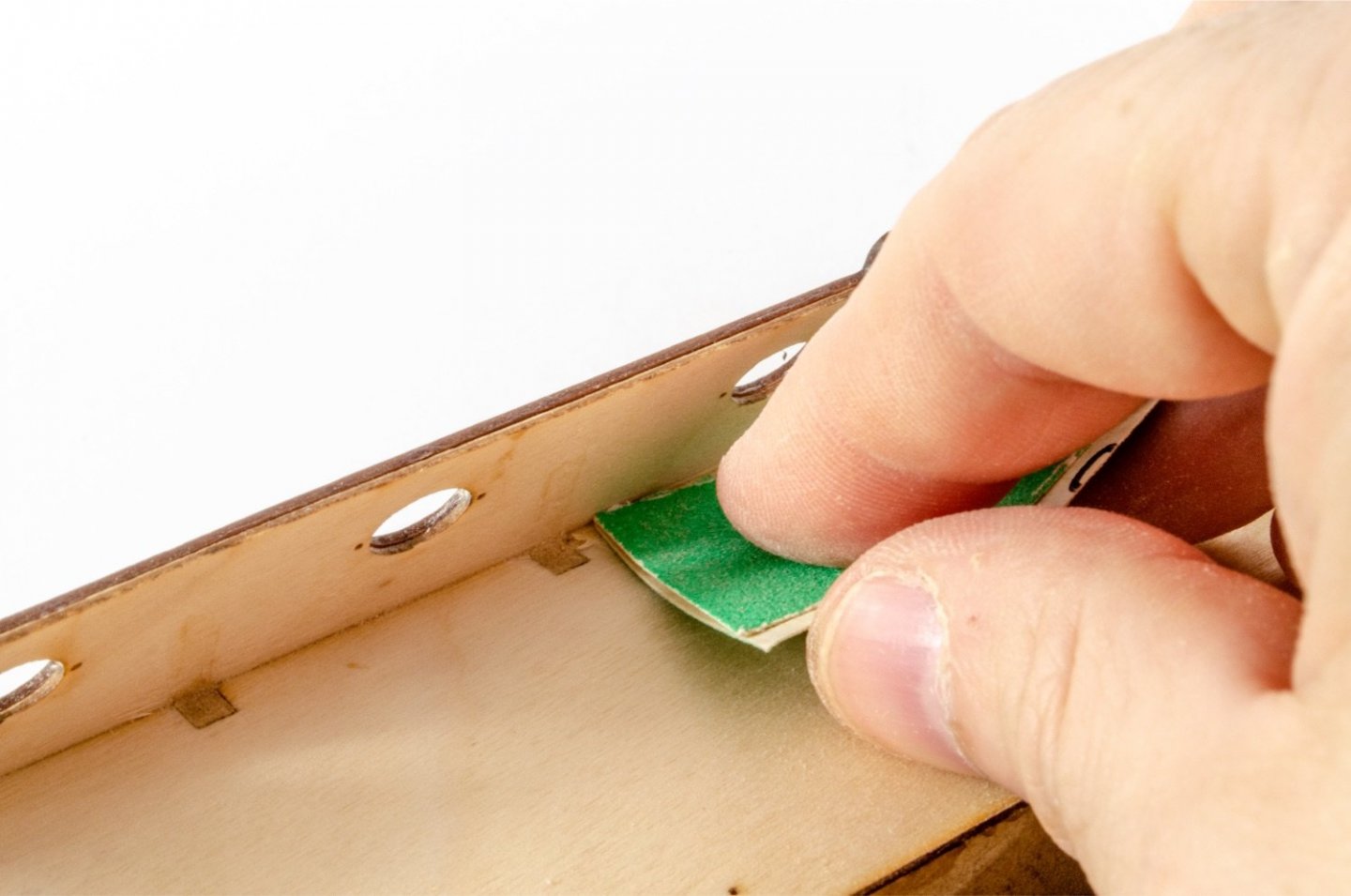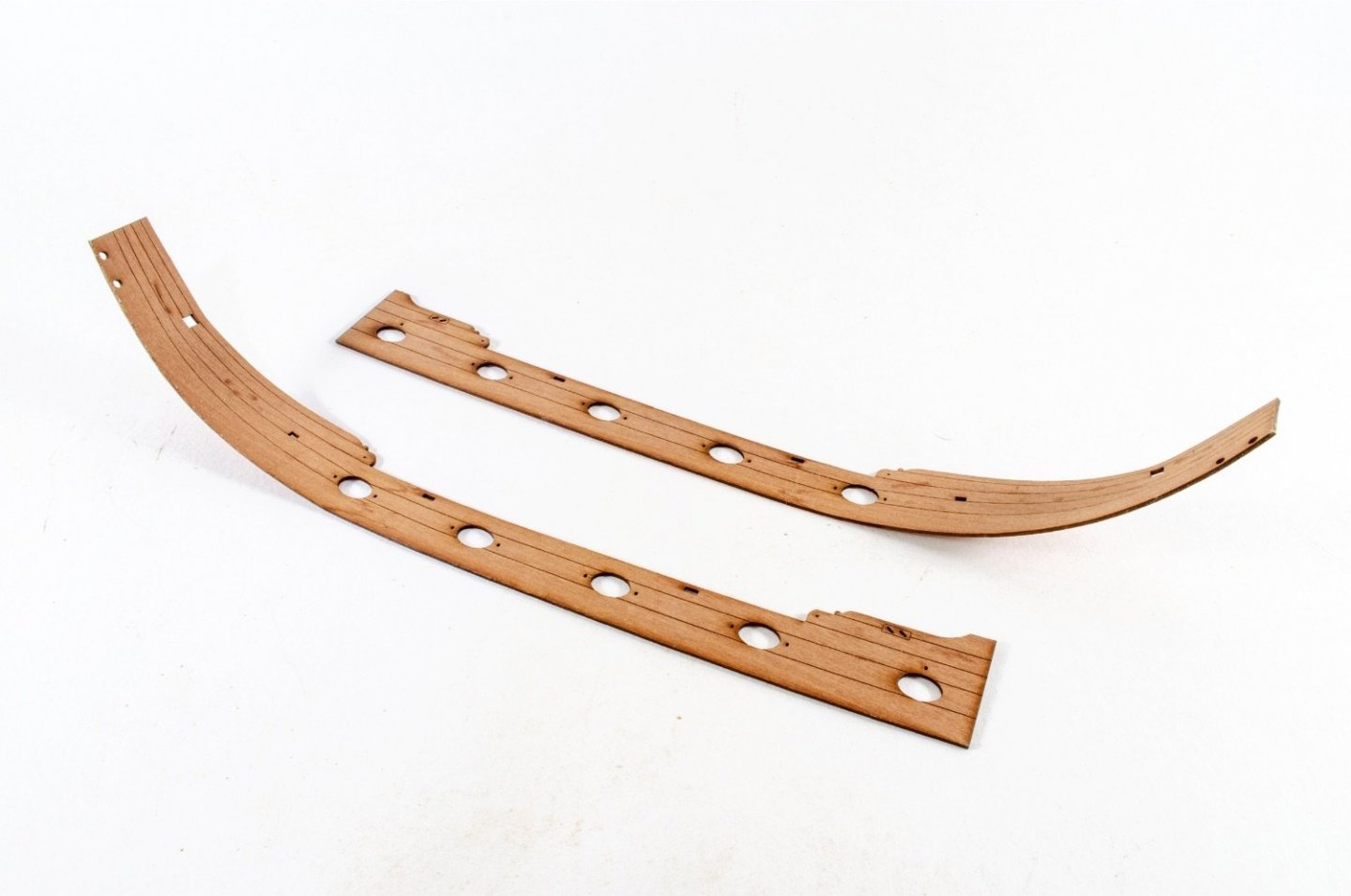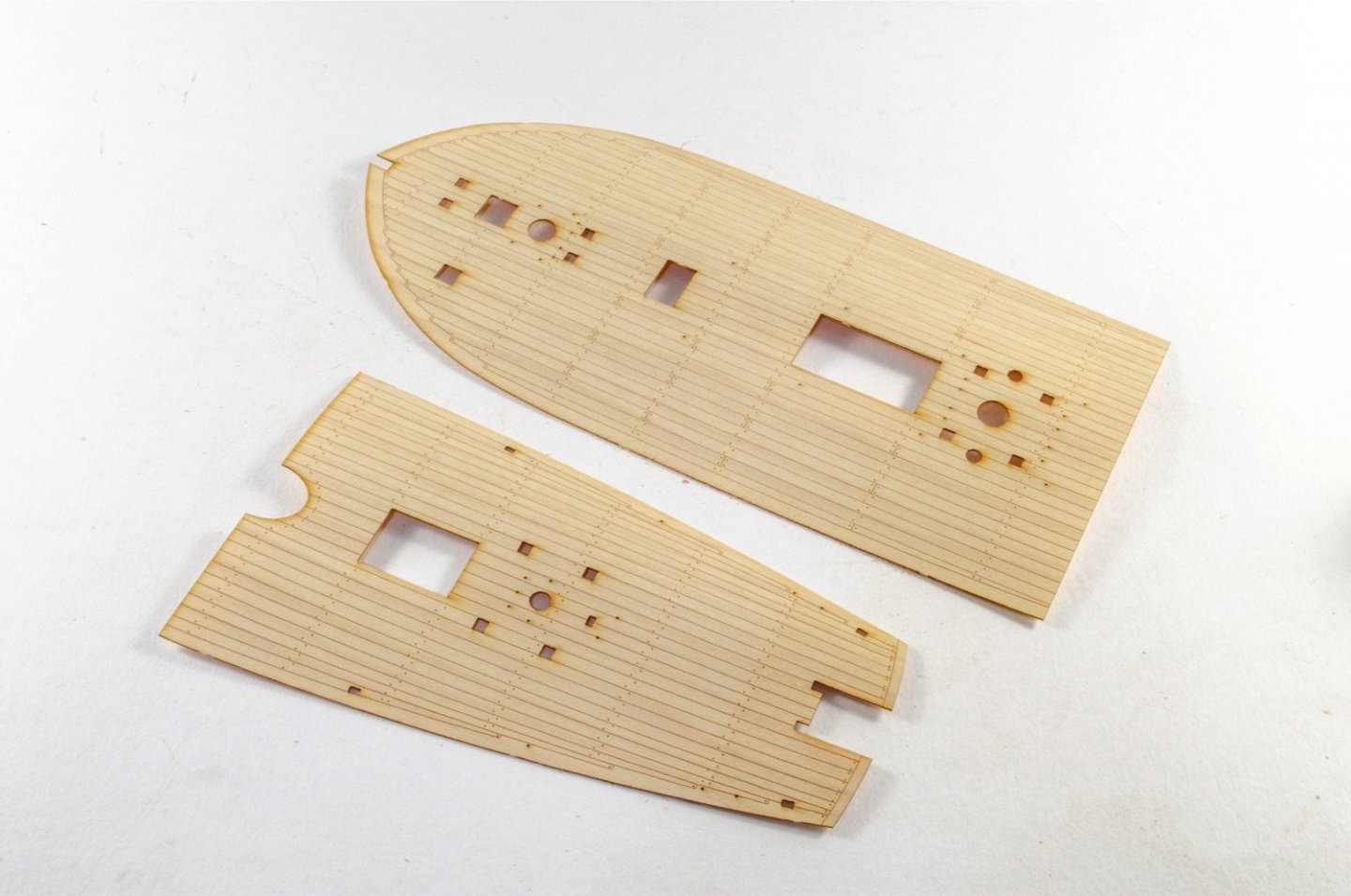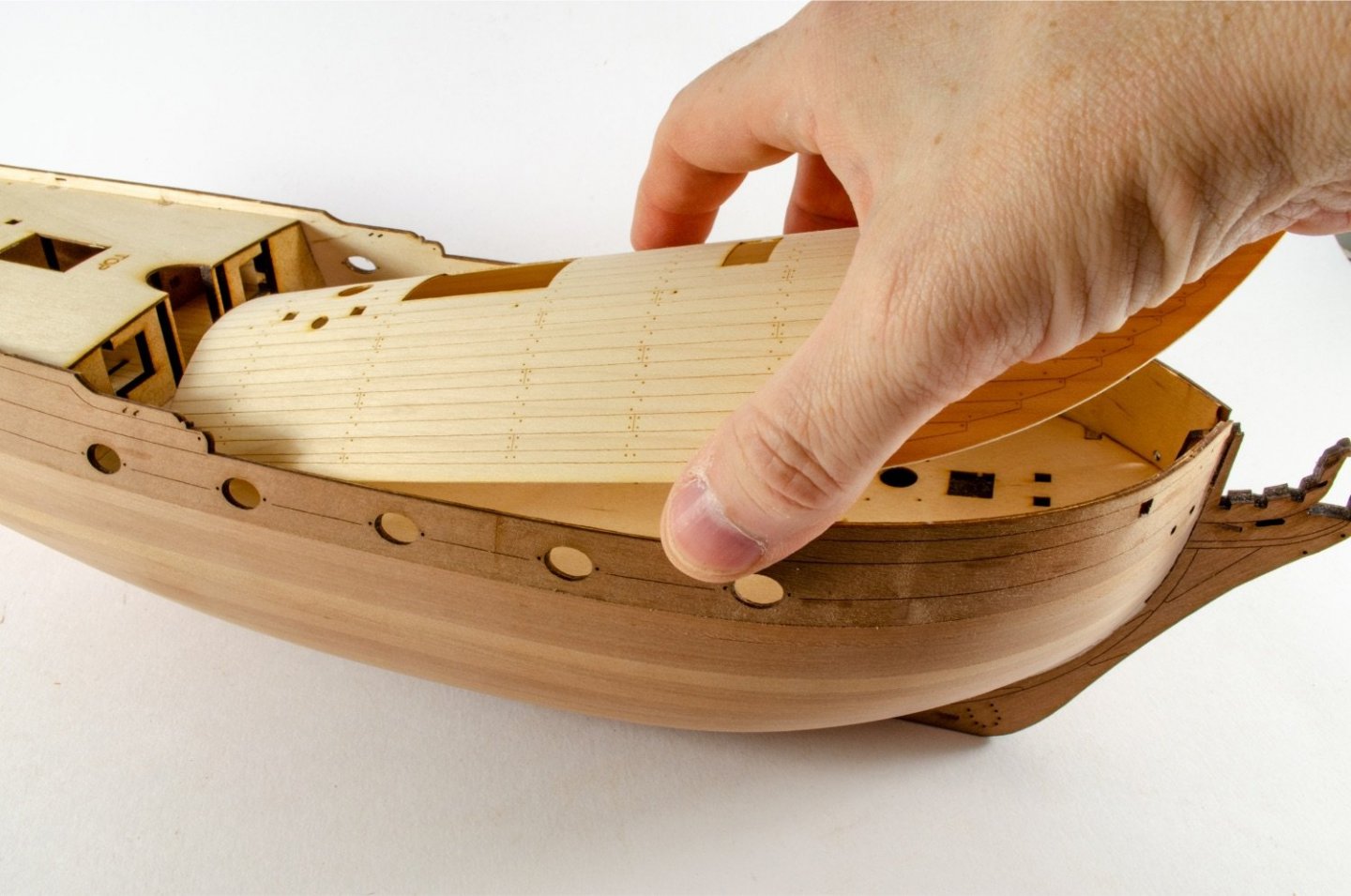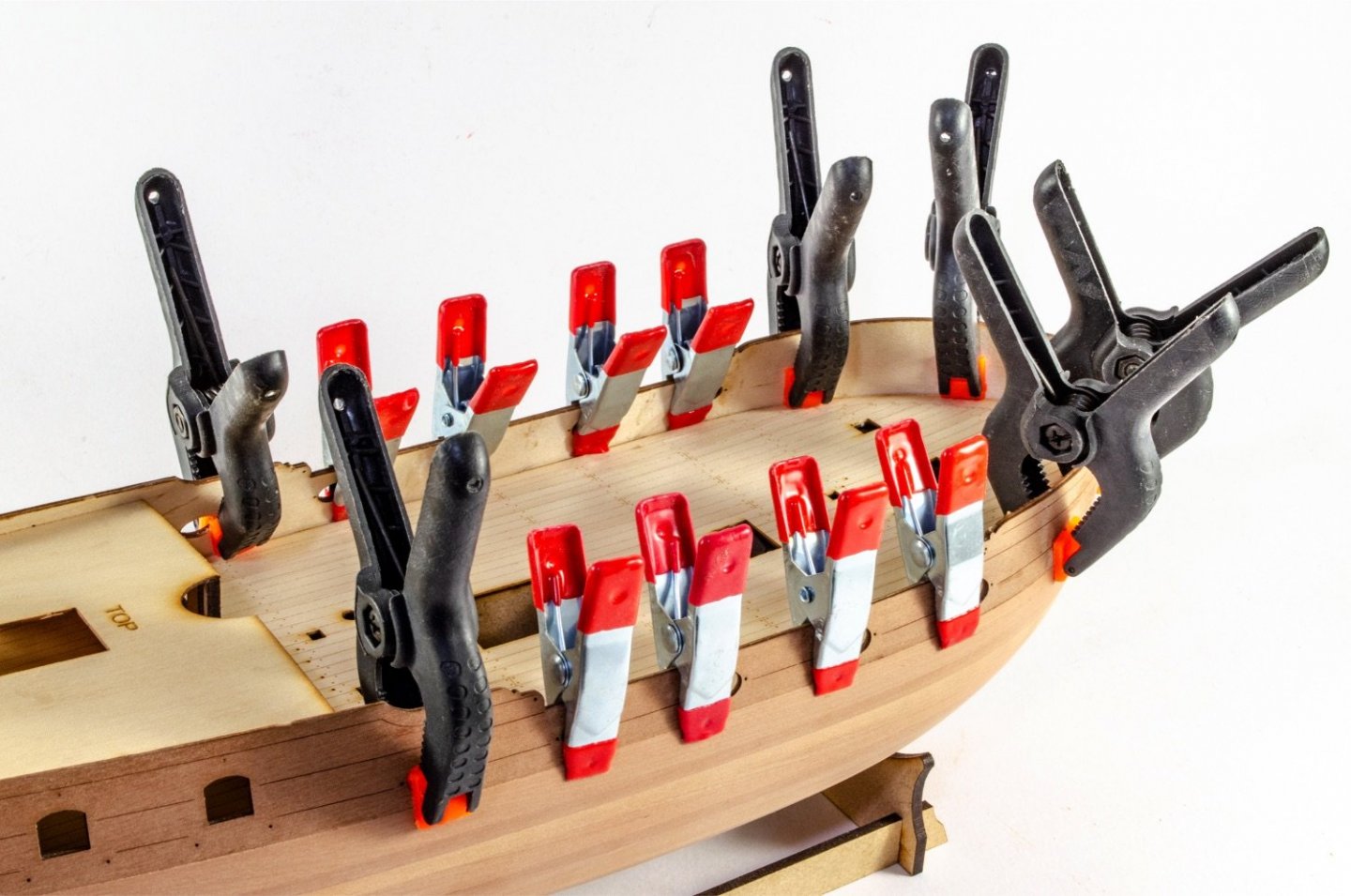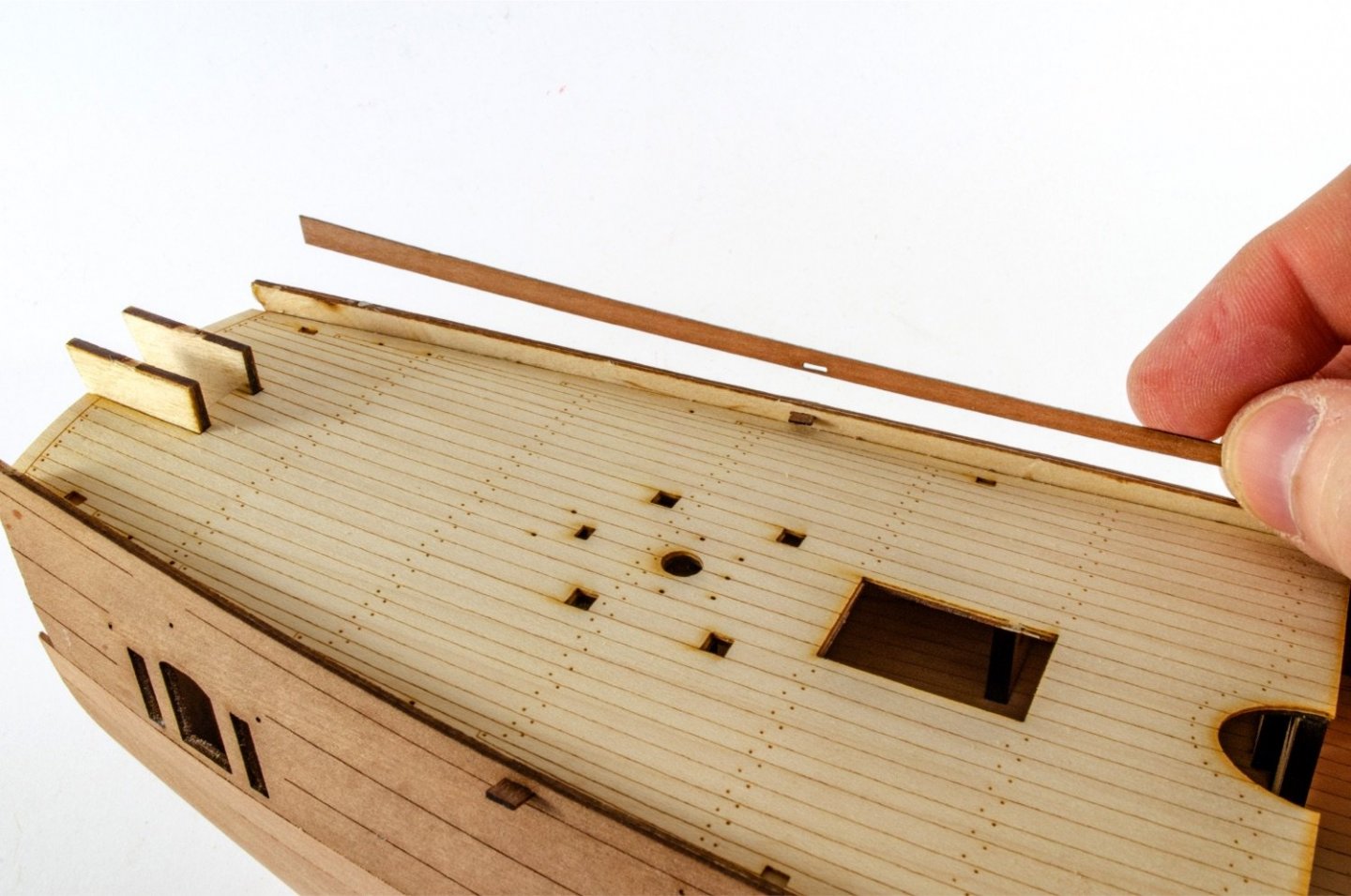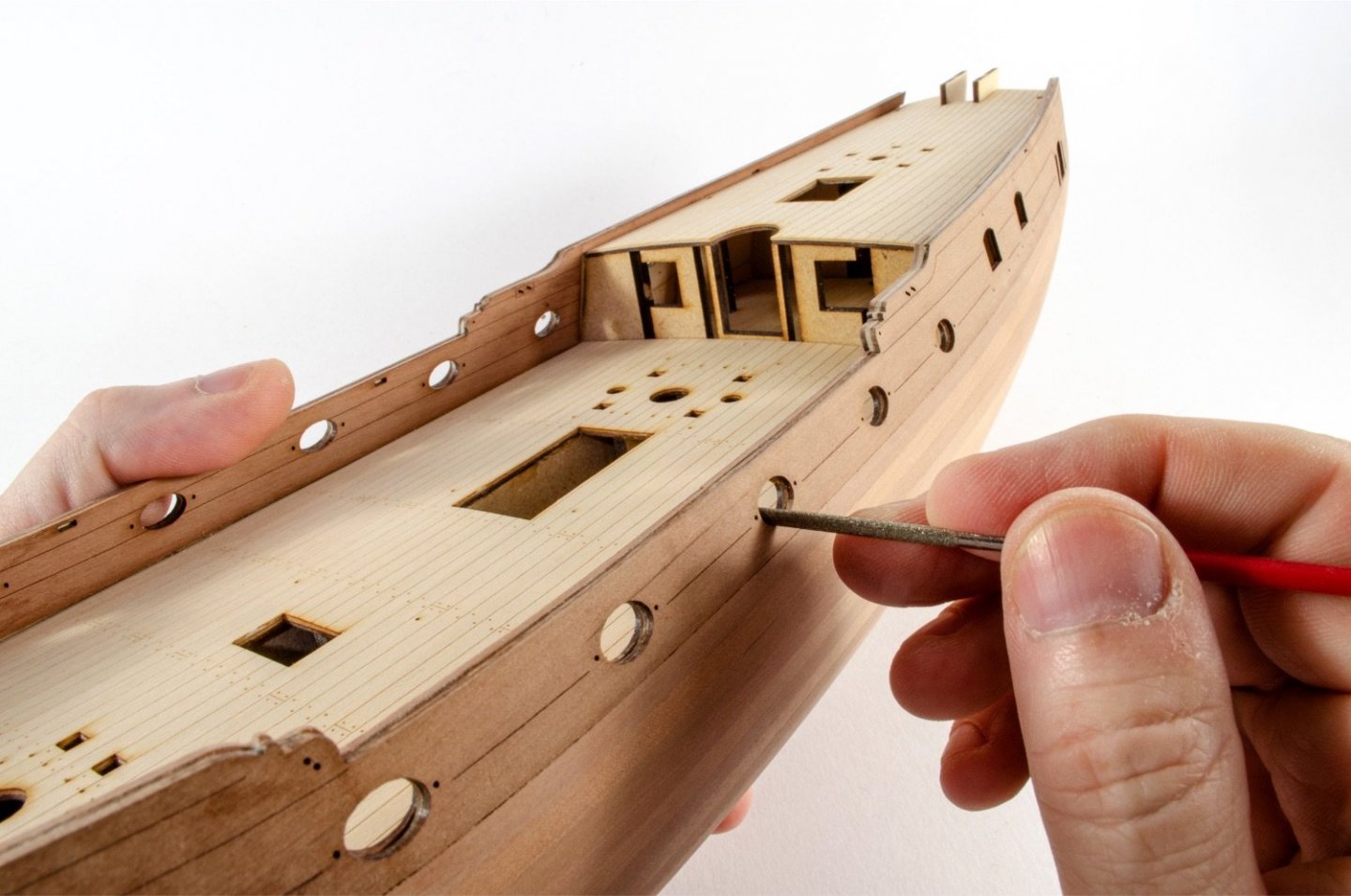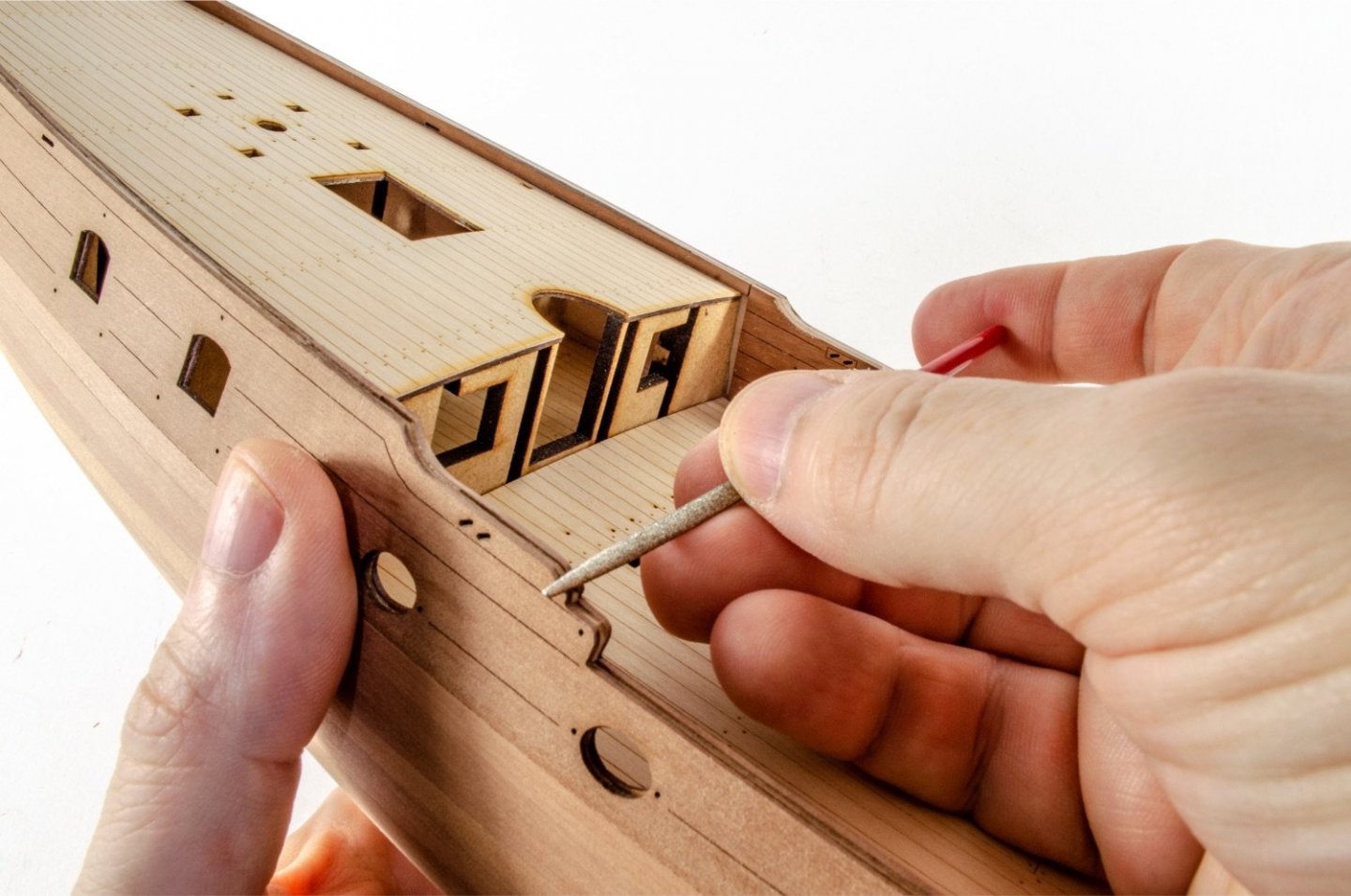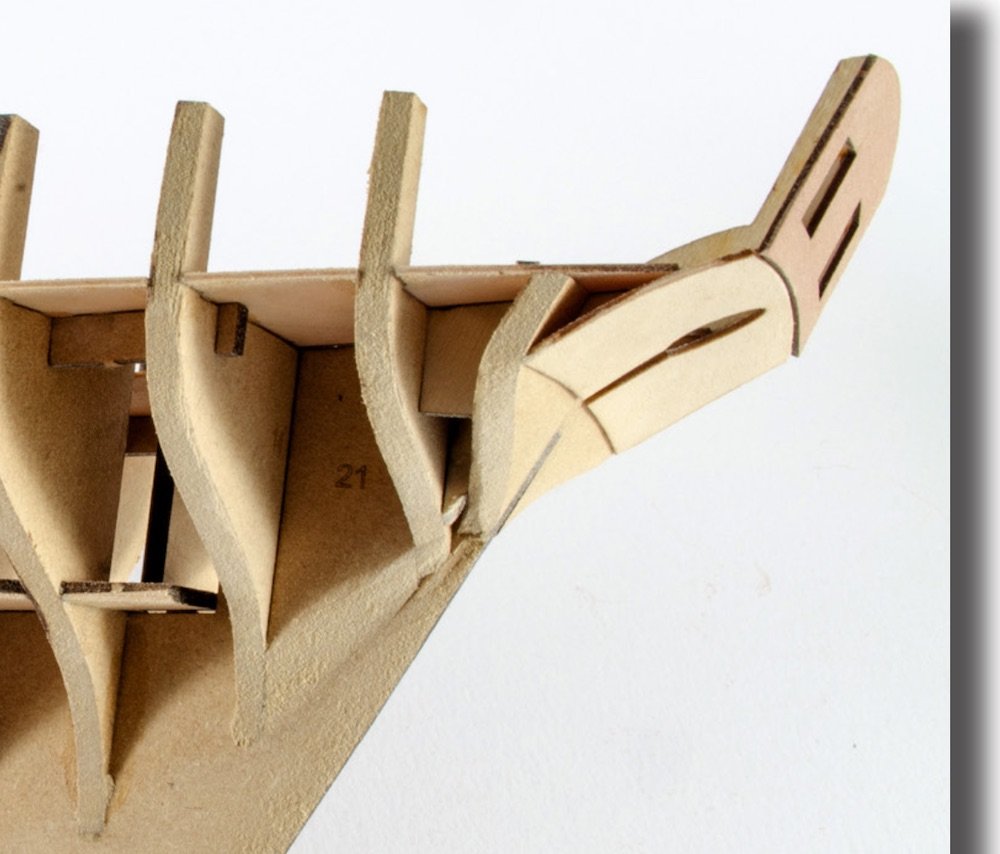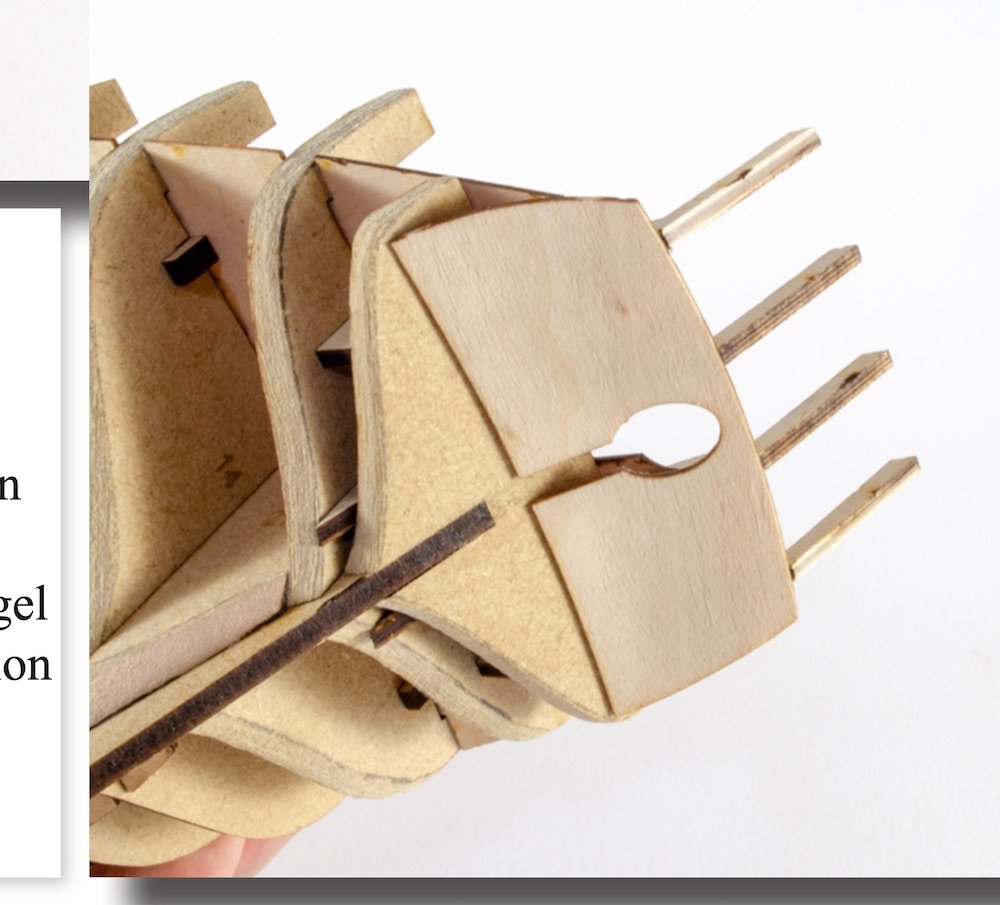-
Posts
6,062 -
Joined
-
Last visited
Content Type
Profiles
Forums
Gallery
Events
Everything posted by James H
-
Ok, I promised an update, and here we are. I've actually done far more than you see here because most of the deck fittings (bitts, cannon, coamings, steps etc.) are now built too. I'll show some of that work in the next update. There are a LOT of photos in this update but they only represent a fraction of what will be included in the manual, as Chris has asked me to detail photo stuff much further than is normally done. The manual should be epic when done! Ok, on with fairing the hull. This one, I found, much more straightforward to sand than Flirt. It certainly didn't take the same amount of time to get the results I wanted. Of course, a lime plank was used to test the flow of the hull with the sanding. With the sanding done, the inner prow is fitted. This is cut from 3mm pearwood. The fit of this is positive and it slots without any ambiguity and is perfectly straight when added, but I still added a few clamps to the mix too. The prow is added at this stage so that the 0.8mm ply bulwarks can plug into it and set the level for the whole length. This one is dead easy as the top of the bulwark should be more or less at the top of the bulkheads. Easy! Oh, if you get worried about the usual inflexible ply and ripple at the bow, then you won't get it with this model. The ply doesn't go to deep, and the shape of the bow is much friendlier than some hulls. First planking is done with 1mm x 4mm lime, pinned as I go along with the very fine Amati pins that Chris supplies. The planks also tuck underneath the lower stern counter, so that's probably the trickiest area, but I didn't find it too bad for the first time I ever attempted doing it. The inner keel is supplied in three further parts. These are self explanatory as you can see with the fore and aft parts. They will only plug into the hull in one position. The stern post is now sheathed in its outer pearwood facings (1mm thick) with laser engraving. This can now be glued to the model. Remember, apart from the sternpost facings, you won't see any of the other work...it'll all be covered over. The stern counter parts are now fitted and sanded. The lower pear is 1.5mm pear and I soaked that for 90 minutes and tightly bound it around a cylindrical 2kg weight and left it overnight to fully dry. The curve was perfect for the model. More engraved pearwood now with the external bulwarks. It's vital that these are glued in exactly the right position, and the various holes adjacent to the windows and cannon ports, align with those in the ply bulwark. The bulwarks are first soaked and bent around the ply, then clamped and allowed to dry overnight. The dry parts are then glued to the model. Pear can swell quite a lot so you really do need to leave anything soaked, for an overnight drying session. With the bulwarks in position the keel outer facings can be added. These create the rabbet for the planking, that Chris introduced with his Zulu and Fifie fishing boats. The parts are located with pear tabs and I also add brass pins thought the horseshoe to doubly align things. Second planking is done with 1mm x 4mm pear. I Managed to get three un-tapered planks in before tapering began. With this model, I only found the need to taper just one plank at the stern! As there is more real estate to cover there, I wasn't going to complain. All pear planking was done with Gorilla Glue CA gel. Once the hull is sanded smooth, I marked a temporary waterline on the hull and many slight gaps below the waterline were filled with diluted acrylic filler, and all sanded smooth. Above the waterline, any gaps were pretty much either invisible or non-existent. With the hull prepared, the temporary beams are removed, along with the bulkhead tabs. The remnants are sanded flush with the false deck. Before the maple deck is laid, the inner pear bulwarks are soaked and clamped around the inner ply bulwark and left overnight to dry. A little edge sanding is needed to make sure these maple decks fit snugly. They are quite flexible, and they need to be to be able to get the parts into position due to the bulwarks that lean inwards. They are still nice and easy to fit though. Dilute white glue is applied to the maple deck sections and then they are stuck down, with clamps around the edges. Upper bulwarks now put in position. Small oval MDF plugs are supplied to help align the main, inner bulwarks. With everything set, a sanding stick is used to level the tops of the bulwarks, even though they were very close anyhow. I used my tiny set of tungsten carbide files to clean up inside the gun ports and the rail decor areas. I'll post another update next week with more hull work and I'll show some deck fittings too. More next time...
- 117 replies
-
- vanguard models
- yacht
-
(and 2 more)
Tagged with:
-
I will have in a day or so. Just finishing up the current stages I'm working on.
- 117 replies
-
- vanguard models
- yacht
-
(and 2 more)
Tagged with:
-
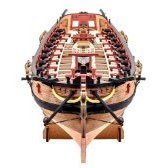
Also "new" member after a long shore leave
James H replied to SkerryAmp's topic in New member Introductions
Great to see a familiar name back in the fold 😙 -
- 164 replies
-
- vanguard models
- flirt
-
(and 1 more)
Tagged with:
-
More like a jigsaw 🤣 Can't wait to see you make and fit those frames.
- 312 replies
-
- enterprise
- caf
-
(and 1 more)
Tagged with:
-
I know some purists hate it, and also talk of it crumbling away in years to come, but I used CA (gel). I've seen models that are decades old and made with CA, and they are still just fine. ...but this isn't a discussion on the merits/demerits of glue. It just works for me and of course, no clamping.
- 164 replies
-
- vanguard models
- flirt
-
(and 1 more)
Tagged with:
-
Beautiful job, Martin. That case really sets it all off too. Stunning Big question.....what project next?
- 122 replies
-
- caldercraft
- agamemnon
-
(and 1 more)
Tagged with:
-
Can't wait to see you build this. You've paving the way for me and Coureur 😄
- 312 replies
-
- enterprise
- caf
-
(and 1 more)
Tagged with:
-

ancre Coureur by cafmodel - 1/48
James H replied to cafmodel's topic in - Build logs for subjects built 1751 - 1800
That's the plan, as soon as I have enough of the Duchess built for Chris to get his manual done and kit into production. @cafmodel Exciting to see things coming together like this. I really can't wait to see this and to get a log started here. I'll certainly be out of my comfort zone with a POF! -
Welcome back! I'm pretty sure I remember you (back in my Captainpugwash days). Looking forward to seeing you crack on with a build here again.
-
There's no difference between port and starboard bulwarks. Those are exactly the same.
- 164 replies
-
- vanguard models
- flirt
-
(and 1 more)
Tagged with:
-

ancre Coureur by cafmodel - 1/48
James H replied to cafmodel's topic in - Build logs for subjects built 1751 - 1800
As soon as DoK is done, I'll build this alongside Victory.
About us
Modelshipworld - Advancing Ship Modeling through Research
SSL Secured
Your security is important for us so this Website is SSL-Secured
NRG Mailing Address
Nautical Research Guild
237 South Lincoln Street
Westmont IL, 60559-1917
Model Ship World ® and the MSW logo are Registered Trademarks, and belong to the Nautical Research Guild (United States Patent and Trademark Office: No. 6,929,264 & No. 6,929,274, registered Dec. 20, 2022)
Helpful Links
About the NRG
If you enjoy building ship models that are historically accurate as well as beautiful, then The Nautical Research Guild (NRG) is just right for you.
The Guild is a non-profit educational organization whose mission is to “Advance Ship Modeling Through Research”. We provide support to our members in their efforts to raise the quality of their model ships.
The Nautical Research Guild has published our world-renowned quarterly magazine, The Nautical Research Journal, since 1955. The pages of the Journal are full of articles by accomplished ship modelers who show you how they create those exquisite details on their models, and by maritime historians who show you the correct details to build. The Journal is available in both print and digital editions. Go to the NRG web site (www.thenrg.org) to download a complimentary digital copy of the Journal. The NRG also publishes plan sets, books and compilations of back issues of the Journal and the former Ships in Scale and Model Ship Builder magazines.

